

HarvesTimes
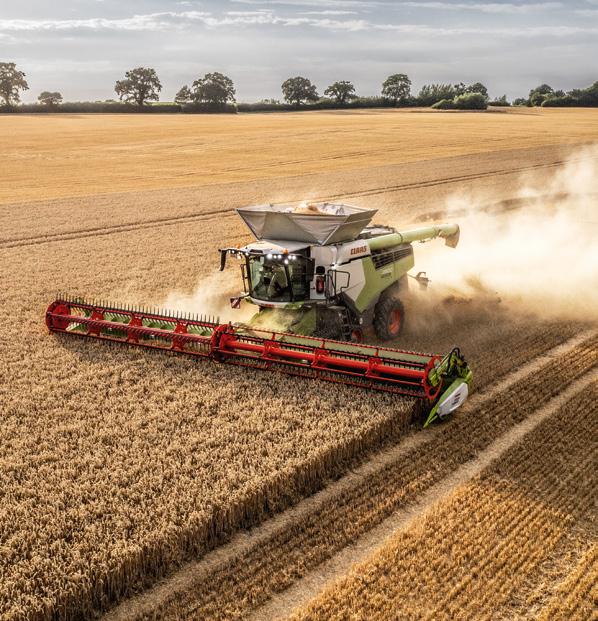







Steven Pennington – DOMINATOR 96
Customer Testimonials
James Peck – 4 x LEXION 8700TT
John Walker – LEXION 5500 MONTANA
750TT
530 MONTANA
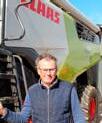



















Ongoing facility investment
Recent years have seen considerable investment being made by CLAAS in its combine production facilities at Harsewinkel, tractor plant at Le Mans, the new UK headquarters at Saxham and a similar facility at Ymeray in France.
This was only just the start of the company’s investment in its production facilities as it strives to meet future demand and ever higher manufacturing standards, along with the demands placed on manufacturing facilities for ever larger and more complex machinery.
BAD SAULGAU
One of the largest infrastructure projects is at the CLAAS Bad Saulgau factory, which is home to the company’s Green Harvest range of machinery. Here, work started in 2021 on the €50 million ‘Forage Go’ project to restructure and expand the production facilities.
The CLAAS association with the town goes back to 1969 when the company bought Bautz, well known for their forage harvesting machinery and tractors. Recent years have seen the continual development and expansion of the site through the acquisition of adjoining land, with the full support of the local community. In 2000, the site covered 90,000m2 and employed 550 people. Currently it now covers 190,000m2 with over 800 employees.
Following a review of future volumes and production demand conducted in 2020, central to the expansion of the site is a new logistics centre costing around €20 million. The production areas have also been expanded and modernised, including relocating the JAGUAR crop flow unit production line into a new assembly hall located in a building adjacent to the site which had previously been a DIY supermarket.
HARSEWINKEL
At Harsewinkel there are two major construction projects underway, with a total investment of around €60 million. Work on the redevelopment of the 8,900m2 Hall 2, which was originally built in 1955, is due for completion this Autumn. The new building, which was erected this summer, has been built to the latest energy standards, including insulation, heat exchangers and active lighting control. Production is due to begin in the Spring, when it will be used for the manufacturing of automated combine components.
Elsewhere on the site, a new central incoming goods area has been completed. Totalling 4,800m2, the new building brings the entire incoming goods department under one roof, and uses geothermal energy for sustainable heat generation and solar PV for energy.
LE MANS
At Le Mans, work is under way to construct a new automated small parts warehouse for cab production. When complete, this will hold up to 20,000 small parts boxes and move 600 parcels an hour. A new CLAAS Hub has also just been completed and the Technoparc enlarged. The Hub provides additional workshop and office space for about 100 employees in eight different departments, mainly working on project related tasks.

Bad Saulgau
CLAAS Foundation celebrates 25 years
It is 25 years since Helmut Claas first established the CLAAS Foundation, with the aim of promoting and supporting young talent within agricultural engineering.
The Foundation works closely with a jury of international experts in agricultural science, as well as with renowned colleges and universities in Germany and abroad, including Harper Adams University in the UK. The foundation capital amounts to around €14 million. In addition to the Helmut Claas Scholarship, the CLAAS Foundation also supports international research projects at universities and promotes initiatives at schools to get pupils interested in science and technology.
“The CLAAS Foundation has developed steadily over the past 25 years,” said Cathrina Claas-Mühlhäuser, Chairwoman of the Board of Trustees. “With its diverse initiatives, it supports research in agriculture and agricultural technology and makes
In all, around 200 students have so far benefitted from the €2.5 million in funding that has been awarded by the Helmut CLAAS Scholarship awards since the Foundation was established in 1999.
the possibilities and prospects of modern agricultural technology tangible - especially for the younger generation, but also for the general public. This was a matter close to my father’s heart and is still close to mine today.”
In all, around 200 students have so far benefitted from the €2.5 million in funding that has been awarded by the Helmut CLAAS Scholarship awards since the Foundation was established in 1999.
To mark the occasion, a 25-year-old Plane tree was symbolically planted on the CLAAS site, symbolising the steady growth of the CLAAS Foundation, and in June, former scholarship holders came together for an alumni reunion. “Maintaining personal contact with our award winners in the long term is important to us,” emphasises Sylvia Looks from the CLAAS Foundation’s Executive Board. The award ceremony, which takes place every year in October and honours the new young talents, will form the festive conclusion of the anniversary year.
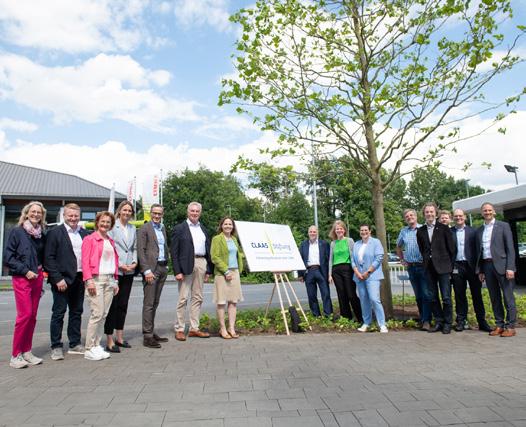
A tree was symbolically planted to mark the Foundation’s birthday. The Board of Trustees, Executive Board and employees celebrated the start of the Foundation’s anniversary year.
6 CLAAS NEWS
Congratulations on 50 years
Past and present colleagues recently came together for the presentation of 50 Years Long Service Awards made to Neil Smart and David Crick, who both work in the Parts department at CLAAS UK and are well known to many local customers. Both were due to start apprenticeships back in September 1974, but prior to joining were asked if they could help out in the stores during the summer for harvest. After enjoying it so much, they decided to forego their apprenticeship and continue working in Parts.
While working in the CLAAS Parts department has always been central to their 50 years at Saxham, for 10 years in the 1990s, they split their time working in the Parts department during the busy harvest period, with helping out in the Wholesale Assembly Workshop, building new machines.
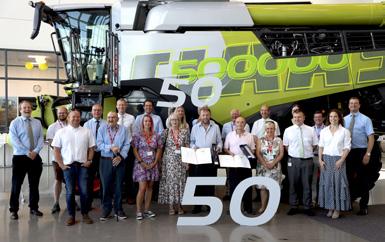
Everyone at CLAAS UK is greatly appreciative of the loyalty and dedication that both Neil and David have provided CLAAS and its customers throughout the UK over the past 50 years, and will continue to benefit from their extensive knowledge as both of them show no signs of retiring yet!
New Digital Business Team
Ahead of the launch of CLAAS connect and to support both dealers and customers in this rapidly expanding side of the company, CLAAS UK has set up a new Digital Business Team. Led by Rob Fillingham, Head of Digital Business, the Digital Business team has been organised to reflect and differentiate between machine mounted and office-based digital solutions.
Andy Bell has joined CLAAS as the Digital Product Manager for Onboard Digital Solutions. Andy is responsible for all the digital product offering incorporated into CLAAS products, including CEMIS 1200, correction signals and machine connectivity for the transfer of data from the machine to the Cloud.
Responsible for all Offboard Digital Solutions is James Walsh. As Product Manager, he will oversee the new CLAAS connect platform, incorporating the existing CLAAS TELEMATICS system and all other new office based digital solutions.
Providing sales support for dealers and customers in the field are Digital Solutions Consultants Simon Brownless and David Thornton. Responsible for England and Wales, Simon brings extensive experience to this new position gained from his previous roles within CLAAS, while David, who has a passion for technology and is based in Ireland, will support dealers in Ireland and Scotland.
Also joining the CLAAS Digital Business Team are Gavin Ludkin and Sam Turnnidge. As the new Digital Solutions Training Instructor, Gavin will be responsible for preparing and delivering

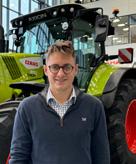
sales and service training courses in the CLAAS ACADEMY. In his new role as Technical Specialist, Digital Solutions and Tractors, Sam Turnnidge has extensive knowledge of OEM steering systems in addition to ISOBUS applications, and will provide technical support for the CLAAS range of digital products and services, in addition to supporting the CLAAS Tractor product range.
Andy Bell
James Walsh
XERION 12 makes UK debut

The first XERION 12 to arrive in the UK made its public debut this Autumn at a series of TERRA TRAC Roadshow working events, where it was working alongside an AXION 960 TERRA TRAC, before going on to be centre stage at Tillage Live.
Since its launch, the XERION 12 has swept the board when it comes to industry awards, winning four major awards in as many months. At Agritechnica, the XERION 12 was named the overall Tractor of the Year in the main category of the awards, before receiving the Farm Machine 2024 award in the Large Tractor category.
In December, the American Society of Agricultural and Biological Engineering (ASABE) awarded the XERION 12 with one of its AE50 awards, which recognise the most innovative new products and product innovations in the USA. This was followed in January with the XERION 12 winning the Grand Prix in the ‘International Product Development’ category at the AGROmashEXPO in Hungary.
With a maximum power output of 653hp, but also available in a 585hp version, the new XERION 12 Series is currently the most powerful CVT 4-wheel drive tractor on the market, and also the largest built in Europe.
Everything about the new XERION 12 Series is big and powerful – whether it’s the substantial central frame that the XERION is built around, the impressive 3,100Nm of torque generated at just 1,300rpm by its Mercedes engine, the enormous 537 l/min hydraulic system or its spacious 4m3 cab. The only thing small about it is its fuel consumption and running costs.
Drive to the four TERRA TRAC units is through the latest
generation CMATIC continuously variable transmission. The CLAAS designed and manufactured TERRA TRAC units have a two-part frame that enables the two pairs of mid-rollers, which are mounted on bogies, to adapt to ground contours independently of the main frame. Large rubber blocks between the undercarriage and the main frame of the crawler track assembly effectively buffer bumps and vibrations.
At 4m3 the cab, which has full 4-point suspension, is currently the largest command centre in the premium tractor segment. Factory fitted footrests are available, plus there is the option of standard, cotton or leather upholstered seats that rotate through 40° to give the driver a perfect view of attached implements.
Key functions are operated and monitored via the ergonomic armrest with CMOTION multifunction control lever and the CEBIS touchscreen terminal. GPS and precision farming options available using the 12-in CEMIS 1200 terminal include automatic steering by GPS PILOT with different correction signals, both on- and off-line Task Management, precision farming applications and ISOBUS with Section Control and Variable Rates Application (VRA).
Discover more about the CLAAS XERION

CLAAS connect pre-launch
Ahead of the launch of the new CLAAS connect digital Ecosystem, a number of farmers around Europe, including Flawborough Farms in Nottinghamshire, have been running a pre-launch Beta stage version of the CLAAS connect programme in order to get their feedback before it is fully launched.
John and Tom Hawthorne have been running CLAAS machinery for many years and using TELEMATICS since it was first developed. Overall, they are farming a total of 3,200ha for themselves and 13 other landowners. In addition they have a contract to supply crops for a nearby AD plant, where they are also carrying out a lot of the arable operations. Within their farming operation, the Hawthornes run two CLAAS LEXION combines, two AXION TERRA TRAC tractors and a couple of JAGUAR foragers.
“We have numerous machines which are dotted around in various different fields and it’s quite hard to rely on human resources to record and write everything down. And we find that generally we are missing information and data,” explains Tom.
“So by using something like CLAAS connect, it allows us to record that information automatically and stick it into one portal for us to be able to access and find that data when we need to, hopefully with all the appropriate information. We use the general tracking all the time when we’ve got machinery working, so we’re able to see where they are. We can also then plan logistics around those machines. Then beyond that there is the auto documentation and the recording of information without any sort of driver input which means that the information is recorded correctly, not forgotten about and is hopefully of high quality.
“Without a doubt the machinery tracking is really important to us. Beyond that just the recording of yields and crop moistures, can accurately be recorded into one place.
Tom Hawthorne
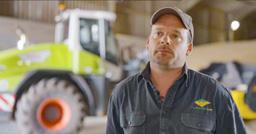
“I’m not having to chase and make sure people have recorded things as they should, but equally I think it’s also made the operators life easier because they haven’t had to record information. I think the integration is very important going forward. It will be nice to also see more data about the implements we’ve got connected and again this auto documentation will allow us to take away the human error and the human reliability of having to record any form of information.
“Because we run pairs of machines, it’s useful for us to be able to compare the sort of performance and the output between the two. This will help us make sure that they’re both performing as well as they should be. Only CLAAS connect allows us to do that. It’s easy to setup and certainly an improvement over TELEMATICS. The presentation is a lot better, and more intuitive to use.
“The yield maps presented in CLAAS connect are better than the previous TELEMATICS software. I think the intuitiveness of it and being able to do contour maps or point maps to show to different end users depending on what your requirement is, works really well.”
Joint ‘Dealer of the Year’ winners
This year has seen two CLAAS UK family owned dealerships, RICKERBY and GORDONS, being awarded the prestigious ‘Dealer of the Year’ 2024 Award.
The CLAAS UK ‘Dealer of the Year’ award recognises the high overall level of performance by a CLAAS dealer in the UK and Ireland in four key areas: market share, customer satisfaction, dealer standards and financial benchmarking, and in all these respects both RICKERBY and GORDONS excelled.
With nine branches serving an area from Lancashire and Northumberland up to the Firth of Forth in Scotland, RICKERBY is the largest dealership within the CLAAS UK dealer network. Established in 1865, GORDONS is one of the UK’s oldest dealerships and are based at Castle Douglas in Dumfries & Galloway, with five branches covering the Southwest of Scotland.
The award is a major achievement for both dealerships as it assesses not only the dealership’s overall performance, but the performance of each of their individual branches. The award also reflects the results of the annual Customer Feedback Survey and their high scores again reflects on their commitment to their customer base and the first class customer care service each provide.

Ken Conley of RICKERBY and Neil Montgomery of GORDONS presented with the CLAAS Dealer of the Year award by Trevor Tyrrell and Martin von Hoyningen-Huene.
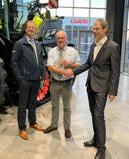
In addition to their ‘Dealer of the Year’ award, RICKERBY were also awarded the ‘Dealer Excellence Award – Gold’ in recognition of the high level of service and support that RICKERBY offer their customers.
The announcement and presentation of the awards to Neil Montgomery of GORDONS and Ken Conley of RICKERBY were made at the CLAAS Dealer Council meeting, held recently at the CLAAS Tractor factory in Le Mans, France.
Congratulations to the 2024 Graduates
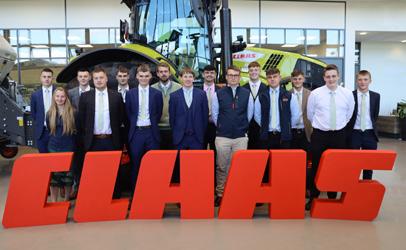
This Autumn, 19 CLAAS Apprentices completed their fouryear Land-Based Engineering Apprenticeship and started their careers as fully qualified CLAAS Service Engineers. In early October, we welcomed 16 of them, along with their family members and dealership representatives to Saxham for their Graduation Ceremony. Unfortunately three were unable to attend as they are currently in New Zealand or Australia where they are participating in the Landpower Exchange Programme run by CLAAS UK.
The Graduation ceremony is just the start of their careers.
Ofsted praise
In its first full inspection by Ofsted, the CLAAS ACADEMY and its team of Apprentice trainers has been recognised for the high level of training provided.
CLAAS is the only UK machinery manufacturer to deliver a specific in-house apprenticeship programme under one roof. Delivered by dedicated CLAAS trainers alongside specialist trainers from the ACADEMY, the Apprenticeship provides students with the highest level of training, knowledge and skills to better meet the demands and expectations of both CLAAS dealers and their customers.
Of the training that the students receive, in rating it as ‘Good’, the Ofsted inspectors reported that: ‘Apprentices develop the high-level technical skills they need to service and repair machinery such as tractors and combines. They learn from trainers with extensive land-based engineering experience using the latest industry-standard facilities.’
This year’s Graduates are from:
• CLAAS MANNS (Spaldwick, Kent & Market Harborough)
• CLAAS WESTERN (Evesham & Cirencester)
• HAMBLYS (Honiton)
• LEINSTER FARM MACHINES
• MCCARTHYS
• MORRIS CORFIELD (Craven Arms)
• OLIVERS (Luton)
• RICKERBY (Carnforth, Bowburn, Penrith & Carlisle)
• SELLARS (Oldmeldrum x 2)
• SHARNFORD TRACTORS (x2)
Working with their respective dealerships, the newly qualified engineers will have access to ongoing training and development to further enhance their skills with the opportunity to move into more specialised Master Mechanic or higher level Master Technician roles, or move into management positions within their dealerships or within CLAAS UK.
The ceremony marked the end of an era as next year will see the first group of students complete their training and graduate from the in-house CLAAS ACADEMY Apprenticeship programme, instead of at Reaseheath College.
‘Apprentices benefit from training in small groups and receiving individual coaching from trainers. Apprentices are highly motivated to learn new skills which they practice at work.’
In terms of the structure of the CLAAS Apprenticeship course, the report again recognised this as ‘Good’ and that the Behaviour and Attitude of students was ‘Outstanding’.
‘Apprentices learn about engineering materials and using hand tools safely. They learn how to manufacture components to the tolerance of exacting engineering drawings. This provides apprentices with a broad range of engineering skills that apply to their current job and a variety of engineering roles.’
In conclusion, the report stated that: ‘Leaders have developed a range of strategies to improve teaching, learning and the apprentice experience.’
‘Leaders have established a very effective oversight structure for ensuring that training is of high quality.’
500,000 combines and counting
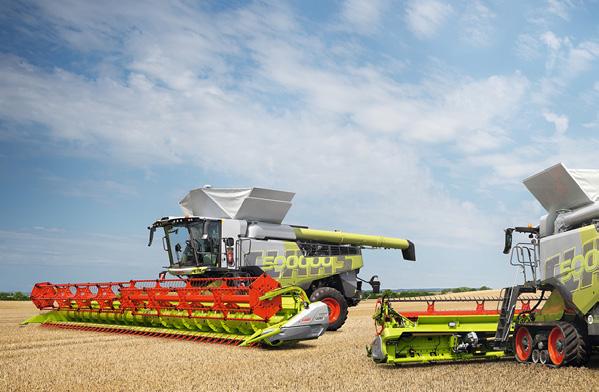
From its first trailed combine manufactured in 1936, CLAAS has led the way in the development of the combine harvester. This year sees CLAAS celebrate half a million machines manufactured, during which time CLAAS combines have reached all corners of the world and set new standards for harvesting efficiency.
In recognition of this major milestone in CLAAS history, in the following pages we catch up with a couple of CLAAS UK customers who still rely on what are now historic CLAAS DOMINATOR combines for harvesting their crops each year.
A HISTORY OF INNOVATION
From the first MTB mowing-threshing-binder combine launched in 1936, it was the development of the SUPER in 1946 that paved the way for the company’s subsequent success with many combine names becoming famous around the world. Production of the SUPER and the SUPER AUTOMATIC eventually ceased in 1978, by which time over 60,000 had been manufactured, providing CLAAS with its first worldwide success.
1953 saw the arrival of the HERCULES, later renamed SF, the first self-propelled combine harvester to be manufactured by the company and also the first combine designed for European harvesting conditions. This was followed by combines such as the EUROPA and COLUMBUS, with around 60,000 of both eventually being manufactured.
The arrival of the iconic MATADOR in 1961 set new standards with a cutterbar width of up to 6.0 m and its claimed output of 3.3t/ hr was industry leading. Further additions to the CLAAS range starting in 1967 included other industry-defining milestones such
as SENATOR, the MERCATOR and PROTECTOR (both in 1969) along with the COMET, COSMOS, CORSAR and COMPACT (1971). It was also in 1961 that CLAAS celebrated its first production milestone of 100,000 machines built.
But it was the launch of the DOMINATOR in 1972 that opened a complete new era that has lasted for more than 50 years and is still in production for the far east market. Models such as the DOMINATOR 6 and DOMINATOR 8 series, and innovations such as 3D cleaning, the AUTO CONTOUR cutterbar guidance and the MEGA threshing unit, all helped consolidate the status of the DOMINATOR as the European market leader. With over 100,000 now built, the DOMINATOR accounts for the largest share of the 500,000 combines now being celebrated.
The DOMINATOR CS with cylinder separation (COMMANDOR CS from 1986) presented in 1981 were among the most powerful combine harvesters in the world at the time, and were first delivered with rubber tracks from 1987 onwards.
But it was the launch at Agritechnica 1995 of a complete new range that was to prove to be a game changer in terms of performance, comfort and ground breaking electronic applications for the emerging precision farming era. With its ground breaking APS hybrid technology, the LEXION 480 was the highlight of the trade fair and set completely new standards for output and cost efficiency. Since then, developments have included both mechanical innovations such the ground-protecting TERRA TRAC chassis technology in 1997 - also available for the TRION since 2021 – but also advances in the area of machine intelligence, especially since 2013. With CEMOS, CLAAS has since become a leader in the field of combine harvester automation and CEMOS continues to be continuously developed and expanded to include additional processes and units in combine harvesters and attachments. The latest members of the CLAAS combine harvester family are the
COMBINE PRODUCT NEWS
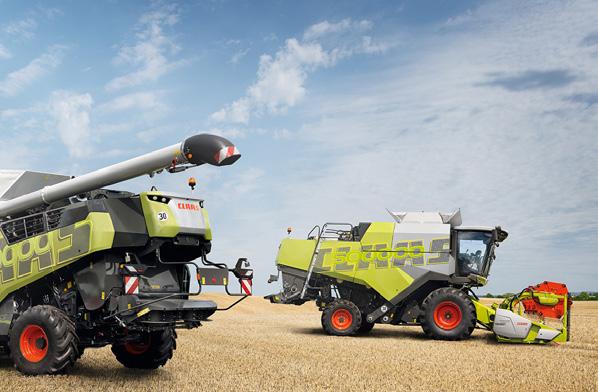
Anniversary machines
As is traditional, CLAAS has produced a number of anniversary machines sporting a metallic silver and seed green paintwork and distinctive 500,000 decals. In addition, all 2025 machines will carry a sticker recognising the anniversary and the fact that a CLAAS combine is ‘More than a machine’.
While sounding simple and straightforward, in reality producing these anniversary machines has been anything but. Due to
TRION and EVION series presented in 2021 and 2023. Together with the LEXION, of which more than 75,000 have now been manufactured, they offer a unique range of products and equipment from the 205 hp five-walker EVION 410 to the 790 hp flagship LEXION 8900 TERRA TRAC with APS SYNFLOW HYBRID.
All three series enable a further increase in threshing efficiency thanks to the DYNAMIC POWER engine management system and expanded CEMOS functions. Depending on the requirements profile, an enormous range of cutting units are available - from the conventional auger cutting unit to ultra-modern, automated VARIO cutting units through to the CONVIO FLEX Draper with a flexible knife bar and flip-over reel control.
AUTOMATION, ASSISTANCE AND DATA MANAGEMENT:
The fact that threshing performance has increased since the first European combine harvester, the MDB, is not only due to further developments in hardware and higher engine performance. Over the last 25 years in particular, automation has become an increasingly important part of further optimisation in the areas of efficiency, productivity and work results.
the use of non-conductive plastics and Alucobond, it was not possible for some components to be painted using the normal powder process, and had to be wet painted. This posed a challenge as once assembled both the LEXION and TRION are too big for even the largest paint booths designed for lorries. Only the EVION could be painted in this way. More than 60 parts therefore were sent off for painting prior to assembly, transported on custom made frames and then fed back into the production line for careful final assembly to avoid damaging the paintwork.
Even as early as 1974 with the Throughput Control Device, CLAAS has been integrating electronic operating aids into combine harvesters. CEMOS, which was introduced in 2013 has proved to be a real game changer and has been continuously expanded to include further processes in the combine harvester and on the cutting unit, enabling optimal utilisation of the machine with a full focus on maximum harvesting performance – supported thanks to the unique multi-crop suitability of all CLAAS combine harvesters. CLAAS was also one of the pioneers in the development of combine harvester technology for precision farming applications. From 1991, yield data and GPS position data could be linked with one another - and from 1996, the LEXION even offered yield mapping via AGROCOM MAP followed in 1998 by telemetry-based fleet management via Combine Online. In 2005, LEXION combine harvesters were the first CLAAS products to be equipped with the ground breaking TELEMATICS. From October 2024, the digital networking of CLAAS combine harvesters with the rest of the fleet, operations management and the CLAAS service and sales partner will take place in the new CLAAS connect, opening a new chapter in the area of digital machine and farm management.
Combine timeline


SUPER Introduction of the SUPER CLAAS SUPER AUTOMATIC with hydraulic operation

100,000 CLAAS combines built

SENATOR, MERCATOR (from 1969) and PROTECTOR (from 1969) as well as the smaller models CONSUL, COSMOS, COMET, CORSAR and COMPACT (1971)


CS TERRA TRAC with rubber tracks
MDB
Introduction of the first European combine harvester, the mowingthreshing-binder (MDB) – 1,400 machines built
JUNIOR & HERCULES HERCULES - the first self-propelled CLAAS combine harvester (later renamed SF)
Introduction of the EUROPA and COLUMBUS (around 60,000 built)
Introduction of the DOMINATOR 80 and 100
200,000 CLAAS combines built
Presentation of the MATADOR with cutterbars up to 6.0m
Did you know?

The GARANT was the last pulled-type combine harvester. Only around 1,000 units were built between 1972 and 1978.
Only 18 units
Introduction of the DOMINATOR 8 and DOMINATOR CS series with cylinder separation
Introduction of the DOMINATOR 6 series
300,000 CLAAS combines built
CLAAS combine harvesters have been available in various different colours. The MDB was light blue, followed by silver for the SUPER through the SF (HERCULES) to EUROPA and COLUMBUS. Since it was too blinding in the sun for farmers in the southern hemisphere, this was changed to “Austral Green” in 1961. In 1967, all CLAAS machines were given a Seedgreen colour scheme for the first time. For export to Hungary, combines were painted yellow to match the demands of the largest customer IKR, a state-operated farming enterprise. CLAAS LEXION combine harvesters marketed in North America from 1997 to 2019 were also yellow. CLAAS combine harvesters were also produced in blue for Ford in America (1966 - 1984) and in red for Massey Ferguson (1989 - 1995).
CLAAS builds the 350,000th combine harvester, a DOMINATOR 108 MAXI

Introduction of TERRA TRAC technology into the LEXION series
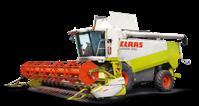
COMBINE PRODUCT NEWS
Start of production of the MEDION 4 and 5 walker combines

Presentation of the new

The new LEXION 600 capable of harvesting up to 70 t/h
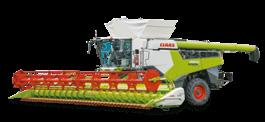
500,000th CLAAS combine built
Premiere of the LEXION 480 at Agritechnica
Introduction of the APS/MEGA threshing system
Presentation of the LEXION 500 series CLAAS builds the 400,000th combine harvester – a LEXION 480
Introduction of the TUCANO series
Introduction of the AVERO

One of the rarest CLAAS combines is the CLAAS Bautz TITAN produced in 1969 after CLAAS took over Bautz. Production was phased out in 1972 as the new DOMINATOR was already in preliminary development at CLAAS.
At the DLG exhibition in Munich in 1968, CLAAS showed a remotecontrolled SENATOR which was the world’s first combine harvester to be fitted with a “steering system”.
LEXION 780 introduced
Construction of the 10,000th TUCANO and the 450,000th CLAAS combine harvester – a LEXION.
Presentation of LEXION 5000 –8000
DOMINATOR 370 starts production in Gaomi - for Asia, Africa and South America the EVION completes the new CLAAS combine harvester family



Still going strong
When it was launched in 1981, the DOMINATOR 116CS was the LEXION 8900 of its time.
With its V8 250hp Mercedes engine it was one of the most powerful combines on the market, while its unique new Cylinder System, comprising of the main drum followed by eight horizontal threshing cylinders, set a new throughput standard.
The DOMINATOR 116CS was only in production until 1984 when, now with a 275hp engine and various other upgrades, it was rebranded as the COMMANDOR 116CS, with the 330hp COMMANDOR 228CS following in 1990, costing a princely £138,500! That summer, a 228CS set a new World Record at Cockayne Hatley, Hertfordshire harvesting 358 tonnes of wheat from 44.5ha in eight hours, giving an average of 44.8t/hr.
For the past 14 years one of the few remaining DOMINATOR 116C’s still in operation is to be found on Chris Templeman’s farm at Witnesham near Ipswich, where it is responsible for harvesting his 60ha of milling wheat. “We have run various CLAAS combines over the years, including a MERCATOR, MATADOR GIANT, PROTECTOR, then two SENATORs and DOMINATOR 96 prior to replacing that with the DOMINATOR 116 in 2010,” explains Chris, who is also Chairman of the Suffolk Farm Machinery Club.
“It has always been a local machine and a friend who did a bit of contracting with it had it for 20 years. When he decided to sell it, it was too good an opportunity to miss as it only had done about 2,000 hours and was quite a step up from the DOMINATOR 96. I paid £9,000 for it and have since put another 1,000 hours on it, but it still runs as sweet as a nut, and I have not needed to touch the engine.”
Chris says that not having a grain dryer, the DOMINATOR gives him the ability to harvest as and when conditions are right but also protect quality, and that by himself he can comfortably cut around 10ha a day, offloading on the headland.
“It’s still on its original spout and tyres, although I do have a spare set of front tyres that I got for free. The air conditioning still works and its like a fridge sat in the cab. Overall it’s pretty reliable but I do still have the original repair manual just in case. However, it does generate quite a lot of dust so I do give it a good blow down every day, and carry water just in case. The main problems are usually belts and bearings, but those are easily available from MANNS or locally and
every few years I do go through it thoroughly and take all the chains off, clean them and then leave them to soak in oil.”
But for a machine that is nearly 40 years old, while they have been few and far between, its hardly surprising that there has not been the occasional age-related problem. “This year the knife drive gearbox fell off, but that was easily fixed and last year I had to replace the cab door, as the lock packed up which made getting out of the cab a bit difficult! In 2019 the gearbox got stuck in 2nd, but again I was able to source one off another DOMINATOR. The only problem to really stop me was when the tension bearing on the fan failed with the result that a couple of blades sliced into the radiator, which has been about the only expensive repair, but again it was still possible to source all the parts I needed.
“Overall, the only running costs are diesel. It’s cheap combining and the DOMINATOR does a very good job and is still going strong.”
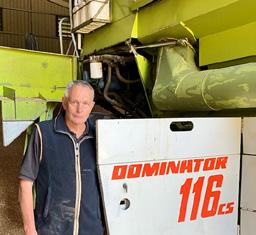

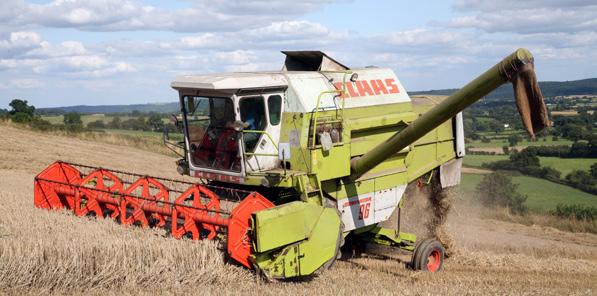
Grain saver
Over the whole of its 40 years and three owners, Steven Pennington says that his DOMINATOR 96 has never been further than 12 miles from supplying dealer MORRIS CORFIELD at Craven Arms, who sold it new in 1984.
The DOMINATOR is fairly unique in that it is one of the few combines still in existence to be fitted with a MANNS hillside rear axle lift kit. “When we bought the DOMINATOR it was a conventional combine. Some of our fields are fairly steep and after we had had it for a couple of years, we came across the lift kit which had been in the nettles round the back of MORRIS CORFIELD’s yard for years, which we ended up buying off them for £200,” recalls Steven.
“We had no idea whether it still worked, but fitted it with new hoses and with some advice from MORRIS CORFIELD my son James did the conversion. Other than working out how to plumb in the hydraulics, it was quite a straightforward job and it has worked a treat since then. The rams still have their original chrome and seals and the kit has more than paid for itself. It’s saved us a lot of grain over the years.”
Each summer sees the DOMINATOR harvesting the 32ha of winter barley that the Penningtons grow as feed and bedding for their 300 head of cattle and 900 ewes at Cardington near Church Stretton.
“Our first CLAAS combine was a MERCURY, which is the only new combine we have ever bought and in due course that was replaced by a MATADOR, which we had for many years. That was followed by a DOMINATOR 85, which was the first combine to have a cab, which transformed the job, but we only had that for a couple of years before the 96 came up. It was local, I knew its history and only paid around £14,000 for it.
“For its age, the DOMINATOR was a very well designed combine and I love driving it. When we bought it, the DOMINATOR had a 12ft cutterbar, but it had had a hard life so after a few years

we found a 15ft cutterbar in the north of England to replace it. It was only when we needed to get a new knife bar for it, that we discovered that the 15ft bar we had bought was too short and that the cutterbar was actually 17ft! Considering its working on a slope, the DOMINATOR copes very well with the amount of crop going through it, and having the rear lift kit is quite useful at the headland in a thick crop in order to lift the rear of the combine so that the hood can clear the swath.”
Other that retrofitting a grain monitor and adding a rear camera, the Penningtons have not had to touch the DOMINATOR, and other than general wear and tear and a new set of front tyres it has been faultless. The only major job they have had to do is to overhaul the brakes a few times which, says Steven, is quite a big job for them but important to do for working on steep ground.
“It’s been a very economical combine to run but the most important thing for us is the support that we get from MORRIS CORFIELD. The teams at both Broseley and Craven Arms are fantastic and it speaks volumes that they are still able to get parts overnight if necessary. James is a trained engineer, so does all the maintenance, but Mark Price at Craven Arms and Mark Rowson and Norman Duppa at Broseley are always there to help and provide assistance and the benefit of their extensive knowledge. I can’t speak highly enough of them,” concludes Steven.
It was an investment in greater overall harvesting capacity. I certainly don’t regret buying them.
James Peck
An investment in efficiency
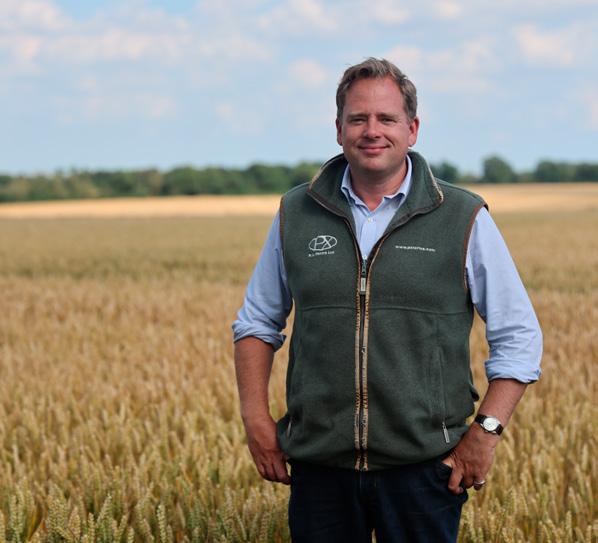
As viewers of his popular YouTube channel will have seen, this harvest saw James Peck of PX Farms take delivery of four new LEXION 8700TT combines which, by the end of harvest, had cleared over 5,000ha and in excess of 27,000 tonnes of crop.
According to James, whose first CLAAS combine was a LEXION 460 bought in 1999, the last new combine he bought was a LEXION 600 back in 2009. Since then, as the farming business has grown, there has been a corresponding increase in combines, bought ex-demo or used, culminating in him running a fleet of four LEXION 780’s, two of which were 2014 machines and the others 2016 and 2017 models.
“Our LEXION were definitely starting to show their age,” says James. “The combines were already at their limit and there will be a further increase in acreage next year. Reliability was becoming
an issue; realistically I could only really rely on having three on the go as there would often be a problem with at least one of them. Not only did this mean that we were still harvesting well into September, but if there was a breakdown, there was a costly knock-on effect on lorries and chaser bins waiting doing nothing.”
Having taken the plunge and replaced all four combines in one go, he says that the impact this has had both on harvest itself, but the wider business has been immense.
“Firstly we had a really good run and finished harvest on 23rd August, which then puts us in a good position for cultivations and drilling, so much so that until the rain came we were well ahead of schedule to complete drilling by our target date of 5th October.
“Also, the chaser bins and lorries were never stood waiting and the lorries made more money because we could release them to go and do other work.”
For James, one of the biggest impacts in terms of efficiency, both of the combines themselves but also the chaser bin and transport support teams, has been TELEMATICS.
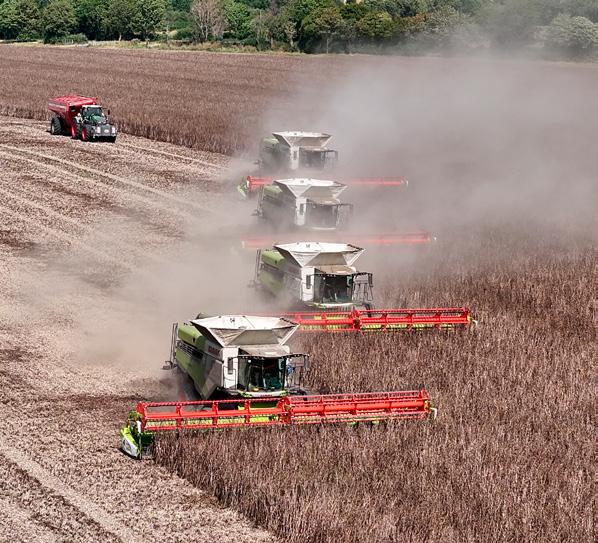
For optimum efficiency, as a rule all four combines work together but occasionally split into two’s, and each of the combines has its own chaser bin in support.
“I am really into TELEMATICS and the information it has provided us on how we can improve efficiency. On any wet days, we would all sit down for a breakfast meeting, look at the data and plan as to how the combines and wider harvesting team could better work together.
“I had a target that each combine should clear at least 50ha a day, and drivers were rewarded for anything over that. Initially we were only doing about 30-35ha, but once we started looking at the data, that soon moved up to 50ha and then we were getting up to 80ha a day. It was a massive improvement.
“Another big impact on efficiency was the 40km/h road speed and the difference this made moving between farms. When travelling from the farm in Lincolnshire to Bedfordshire, due to the faster road speed we saved 2.5 hours. This meant that if we finished in the morning in Lincolnshire, we could move and be harvesting again in Bedford in the afternoon, with the benefit that
the lorries were kept busy. In the past, they would have been idle all afternoon as we moved.”
For James, the biggest factors that have influenced performance of the four LEXION 8700s has been the CONVIO headers, increased tank size, threshing capacity, speed on the road and overall build quality.
“For a combine that superficially looks the same size, I have been really surprised by how different they are compared to the 780s. The CONVIO cutterbars made a big difference, especially in peas. The cab and the overall build quality is a lot better and the larger tank capacity (15,000 litres) was good, while the unloading speed was tremendous.
“Overall it was the right decision to replace all four – costly, but if I had only replaced two they would never have worked together as well. It was an investment in greater overall harvesting capacity, with a knock-on impact both in terms of other savings in the business, but also releasing people to start cultivations and drilling earlier. I certainly don’t regret buying them,” concludes James.
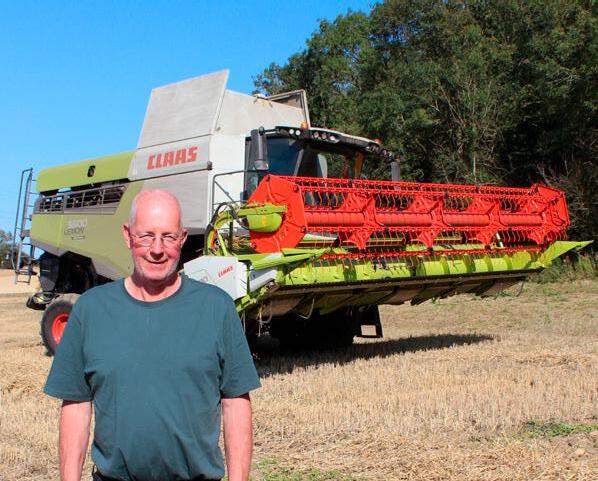
W & JS Temporal has been running the same make of combine for over 30 years, but that came to an end this harvest with a change to a CLAAS shade of green machine for harvesting the company’s 360ha of cereals.
The arrival of a new LEXION 5500 MONTANA has proved quite an eye opener for manager John Walker who drives the combine, with the VARIO cutterbar, cab and APS threshing system all coming in for praise.
Based at Sutton Scarsdale near Chesterfield, John describes it as being a typical mixed farm, working around a 6-course rotation. Oilseed rape and some beans are sold with most of the cereals used to feed the 400 indoor and 600 outdoor sows and their progeny, some of which are sold as weaners and the rest taken through to finishing. In addition up to 140 calves are bought at 4 months for finishing on a TMR ration using home grown cereals, beans and silage, plus the farm has also just bought some Wagyu cattle.
“The main reason for changing after such a long time was due to the decision as part of a national reorganisation to take
A change for the better
the franchise away from our local dealership and the ethos changed completely,” states John. “Even though we had never dealt with CLAAS EASTERN, we work with various neighbours who do and they get on well with them, so with the combine due for replacement we approached them for a price. Will Clark went to a lot of effort to spec up the combine to what he thought would meet our needs and we were surprised when he came back with a far better deal.
“We bale a lot of straw, so wanted a straw-walker machine. Plus we do a lot of roadwork, so being a 5-walker the LEXION 5500 is easy to move about and not too wide to move through villages. Our last three combines have all been hillside machines, but in many ways the MONTANA system is far better as it has lateral compensation (up to 18%), which our previous machines didn’t, and 2 degrees more longitudinal lift (6%).”
The VARIO cutterbar with its direct drive and mechanically driven side-knives with tool free fitting has also been a revelation. “The VARIO cutterbar is phenomenal,” says John. “It makes a huge difference; it just gobbles everything up and I have never yet had to use the header reverse system, which says a lot, plus the side knives are brilliant. We had a header extension for our old cutterbar but in rape it was often difficult to get it to feed right. The VARIO is so much better and feeds really well.”
Being used to a single drum machine, John has also found the APS SYNFLOW WALKER threshing system has taken a bit of getting used to, but been impressed with the grain quality and throughout. Central to the APS system is a 755mm diameter threshing drum, followed by a 600mm wide separator drum then the impeller. The greater diameter of the drums results in a flatter, more gentle wrap angle with a massive 1.22m2 concave area with infinite adjustment of the concaves, while the higher centrifugal speed of the rasp bars means the drums can be run at a slower speed, which helps save fuel.
“I am used to running the drum at 900rpm so slowing it down to around 500rpm and having so much concave adjustment has taken a bit of getting used to. There are so many more components in the APS system, but it is very easy to adjust. With our old combine we always struggled to get a clean barley sample, but the APS does a really good job and engaging the de-awning plates is simple, which it wasn’t on our old machine. The sieve box is also far larger and losses are nil, and I really like
LEXION 5500 MONTANA
the loss monitors which are very accurate, plus having the returns window is such a good idea.
“The LEXION does have a bit more engine power. It has a lot of power in reserve so is comfortably on top of the job and it is noticeable the fuel use is lower. It only really started to grunt in rye due to the amount of straw.
“For the same size machine, overall output is certainly 20% up on our old combine, which at most would do about 20ha in an 11 hour day. The other day I did 26ha in nine hours mainly unloading on the headland due to the slope. Combine technology has moved on exponentially and functions such as CRUISE PILOT definitely help.
“It was only ever going to be between what we ran before and CLAAS. It has taken some time to find my way around and get used to the CMOTION and CEBIS controls, but Will Clarke did a good job in realistically ‘speccing’ the combine and a big help initially setting-up the combine and then sitting with me, which made a great difference. We definitely got the right combine.”

The LEXION does have a bit more engine power. It has a lot of power in reserve so is comfortably on top of the job and it is noticeable the fuel use is lower. John Walker
Focus on TRION

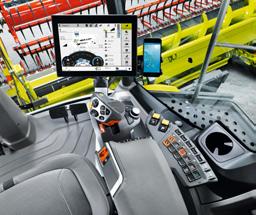
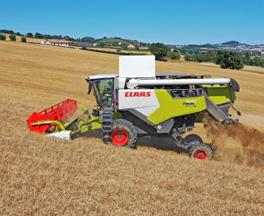

Launched in 2021, the TRION has quickly proved to be a great success with customers throughout the UK and Ireland. The TRION has definitely lived up to the launch slogan of being a combine that could be specified to ‘Fit your Farm’, as is reflected in the three customers featured here.
With a total of 23 models, there is truly something for everybody within the range, whether they are looking for a narrow-width 5-walker machine (TRION 500, 258-354hp), a 6-walker (TRION 600, 306-408hp), a smaller single rotor HYBRID (TRION 720/730, 367/408hp) or a high capacity twin rotor HYBRID (TRION 750, 435hp) Common to all is the well proven APS primary threshing system designed to thresh out 90% of grains, leaving the harder the thresh grains for the secondary separation system. Central to APS are a 450mm diameter accelerator and a 600mm diameter closed threshing drum followed by an impeller. The front concaves are all interchangeable and the speed of all three drums is synchronised and adjusted using CEBIS, which is also used to adjust the concaves, which are also synchronised.
All straw walker models come with the well proven CLAAS Multifinger Separation System (MSS). The straw walkers are 4.4m long and use an open design, with a total separation area of 6.25m2 on TRION 500 models and 7.48m2 on TRION 600.
TRION 720/730 have a single 4.2m long and 570mm diameter rotor with 6 grates, while the TRION 750 has twin 4.2m long and 445mm wide rotors with 5 grates. The rotor flap ‘bomb doors’ are hydraulically adjusted and rotor speed is infinitely variable. JET STREAM 6 or 8 turbine fans complete the cleaning process. Power for the TRION comes from Cummins 6.7 or 8.9 litres engines, all with DYNAMIC POWER, running at a rated speed of 1,900rpm dropping to 1,650rpm for road travel.
No two farms are the same and what sets the TRION range apart is the wide range of specifications available. An unprecedented 7 models are available with either TERRA TRAC crawler tracks or MONTANA hillside compensation, starting with the 306hp, 5-walker TRION 530.
In addition there is an extensive range of options, including a number of different straw choppers and operator aids including AUTO SLOPE fan speed adjustment, CRUISE PILOT, AUTO CROP FLOW and either CEMOS DIALOG or full CEMOS AUTOMATIC.

New addition to MONTANA range
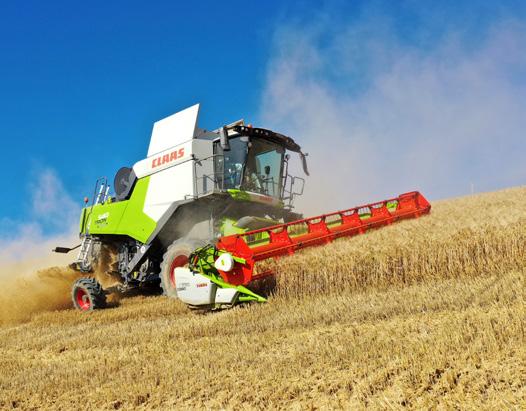
The TRION has rapidly found its place amongst the list of notable CLAAS combines and already accounts for a large share of UK combine sales. A key feature is the wide range of 23 models and within that an extensive range of specification options.
This ensures it can truly be made to ‘Fit your Farm’, whether it be a small mixed farm wanting a simple, straightforward machine or a large arable unit looking to take advantage of all the latest technology to maximise output.
New to the range is an additional MONTANA hill-side version of the TRION 540, giving a total of seven models now available with slope compensation with two hillside MONTANA variants for both the 5- and 6-straw walker TRION models.
Coming in at the top of the TRION 500 5-straw walker range, the TRION 540 has a 354hp engine and 1,420mm-wide threshing
system with JET STREAM cleaning and as standard comes with a 9,000 litre tank.
In addition to the extensive range of options available, even within MONTANA there is the option to either have fully automatic lateral slope compensation of up to 18%, or with the optional MULTI CONTOUR there is also longitudinal compensation of up to 6%.
The wide range of options available also include POWER TRAC all-wheel drive.
As with the rest of the CLAAS TRION range, the TRION 540 MONTANA can be used with the complete range of CLAAS cutterbars and in addition to the 52-knife STANDARD CUT chopping unit there is also the option of the SPECIAL CUT chopper with 72 knives.
In the spacious cab, the operator benefits from the latest 12-inch CEBIS screen with touchscreen control terminal, but all the main combine functions can be operated using buttons in the armrest. The CEBIS terminal also accommodates the controls for CEMIS DIALOG and CEMIS AUTOMATIC where these options are fitted.
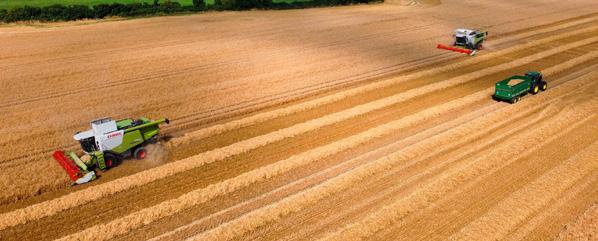
High output game changer

Gerry Purcell is a third generation tillage farmer based in the shadow of the famous Slivenamon mountain in Tipperary. Himself and his father Gerrard grow about 400 ha of cereal and bean crops each year and since 2012 have been using CLAAS harvesters to gather their harvest.
For the 2023 season a new TRION 750 twin-rotor HYBRID arrived onto the farm. The TRION 750 is the first rotary combine that Gerry has used having moved from a straw-walker LEXION, and admits that he was nervous about the straw quality and the ability of the HYBRID system to handle damp crops that he
sometimes has to cut to get through the work during a standard season. However, on both fronts the TRION has completely dispelled any nerves that he had prior to putting it to work.
The TRION was specified with CRUISE PILOT, CEMOS AUTOMATIC and FIELD SCANNER steering on it which basically means that having set the level of max output that he wants to work at, the combine adjusts its forward speed and threshing settings to achieve maximum output and steers itself. Gerry says that this is ‘game changing’ and means that he gets “serious output and I still arrive home in the evening feeling less tired.”
Gerry also uses QUANTIMETER yield measurement in combination with TELEMATICS which he uses to create yield and moisture maps and apply variable rate fertiliser, and says that precision is key to output and profitability. In addition, the TRION is fitted with cameras on the auger and rear of the combine and has 3D TM6 sieves.
Some of the land that Gerry grows crops on is up to 30km away from the home farm and he has found its “tidyness on the road” makes the distance less of an issue. In the field, the other features that Gerry see as ‘game changing’ are the SPECIAL CUT straw chopper which, with its 72 knives (compared to 52 on the STANDARD CUT chopper) makes a very fine chop which is perfect for his minimum tillage sowing system. One feature of the SPECIAL CUT system Gerry is particularly impressed by is the automatic adjustment of the chopper depending on the wind direction, and how it manages to keep an even spread of chopped straw across the full width of the VARIO 770 header.
In order to get the maximum output from the TRION, Gerry tries to offload on the move as much as possible. With the XXL auger and pivoting spout, coupled with the 130 litres/second unloading, this makes it very easy to precisely fill trailers without driving on the swath.
Using all the pieces of technology available to him on the TRION, Gerry has found that he can consistently achieve rates of 40 tonnes per hour and forward speeds of up to 5km/h. That, combined with the sales and service from KELLYS of Borris, which he says has been of the highest quality, means that the TRION has been game changing for both Gerry and his business with the ease of use and output being the stand out features.
TRION 730 MONTANA
Breaking old vows
How Peter Moynan’s switch to a TRION 730 rotary transformed harvesting on the Kent Downs.
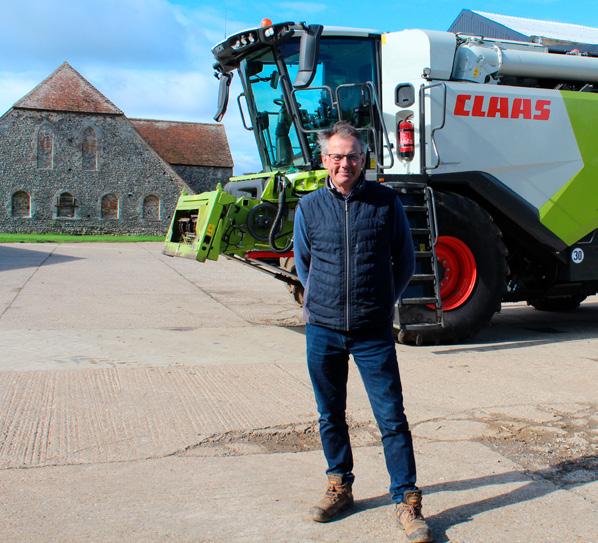
After about 25 years of running straw-walker LEXION MONTANA combines, this harvest has seen Peter Moynan switch over to a TRION 730 MONTANA HYBRID rotary – despite after past experience vowing never to have a rotary again!
“The decision to make the change over to a rotary was made on the back of the difficult harvesting conditions experienced in 2023, and as a result the desire to increase combine capacity in order to maximise daily harvesting output.
THE CLAAS ROTARY
When it came to looking at what the best replacement would be for his LEXION 630 MONTANA, while moving to a 6-walker machine was an option, Ryan Miller from MANNS Kent suggested that the single rotor TRION 730 would realistically be better suited to achieving Peter’s aims.
“We are just 1.5 miles from the coast and 135m above sea level, so we get a lot of sea mist and fog which can restrict how quickly we get going in the morning, hence running a strawwalker combine as it can’t be blocked and will keep going later into the day. Prior to first moving to CLAAS combines I did run a rotary, which I managed to block too many times and vowed never to have one again,” explains Peter, who farms 497ha on the Kent Downs above Dover, of which 393ha is down to milling wheat, oilseed rape, beans and oats.
ZERO TOLERANCE TO BLACKGRASS
Peter has a zero tolerance to blackgrass. By not allowing outside machinery into fields and maintaining a strict hygiene policy where there is blackgrass, levels are such that it can be controlled by spot-spraying with a knapsack.
“Typically I would be looking to start harvest around 20th July and to finish in the third week of August,” he explains. “By having a zero tolerance to blackgrass, this enables us to start drilling early. Oilseed rape goes in immediately behind the combine and with minimal tillage I like to start drilling wheat from 20th September onwards.”
Ancient meets modern. Peter Moynan’s farm buildings are in the grounds of St Radigunds Abbey, established in 1192.
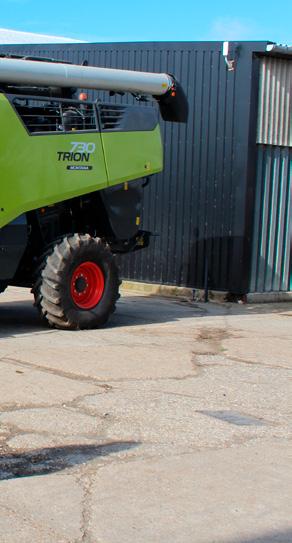
“After my past experience, I was very sceptical when Ryan suggested a rotary. He reassured me that while not 100% guaranteed, the AUTO CROP FLOW technology on the TRION made the chances of blocking it far less, while maintaining maximum output. Harvest ’24 has been straight forward and having finished in good time I do feel far more confident in the TRION. It’s definitely achieved what Ryan said it would and certainly outperformed the LEXION. I reckon in wheat, we have easily seen an increase in output of about 20%.”
MINIMAL LOSSES ON STEEP GROUND
The CLAAS MONTANA hill side system has been a feature on all Peter’s CLAAS combines to compensate for his often steep downland slopes. “MONTANA just works really well and ensures that grain losses are minimal on quite steep ground, but even on fairly gentle slopes we will activate it. It also has other advantages, such as being able to lift the cutterbar over gateposts, which makes moving easy.
“The TRION 730 is definitely a step forward. The cab is extremely comfortable and a nice place to be; the touchscreen CEBIS makes it very easy to set up and alter the combine and the
FOCUS ON TRION
The TRION 730 is definitely a step forward. The cab is extremely comfortable and a nice place to be; the touchscreen CEBIS makes it very easy to set up and alter the combine and the CRUISE PILOT function is fantastic.
Peter Moynan
CRUISE PILOT function is fantastic. It’s so easy to set up, create strategies and set the parameters that you want the combine to work to in order for greater output. If set right and to the conditions, it will generally outperform the operator.
“But it’s also the small things, such as the pivoting spout. I’d be lost without it as it makes it so easy to line up and direct the grain into the centre of the trailer, especially when you are working across a hill.
“The support from MANNS is extremely good and I have also taken out MAXI CARE just for peace of mind and the fact that should we have a breakdown, after warranty I will not have the worry of the repair cost.”
After many years of running a straw-walker LEXION, Peter says that the move to the HYBRID rotary TRION 730 has been like starting again to learn how to operate a combine. Helped by Ryan and MANNS demonstrator James Whitbread, in addition to watching the online training videos and using the DIALOG app, it has been a smooth transition.
FOCUS ON TRION
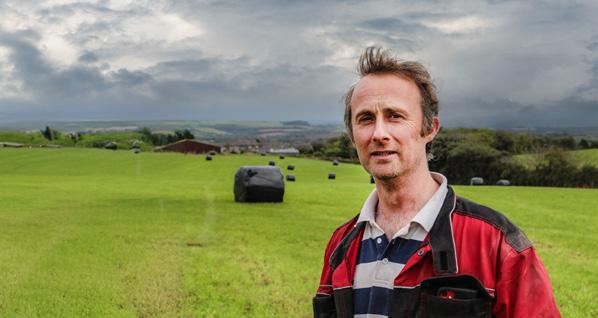
Perfect fit for demanding straw yields
TRION 530 MONTANA
Farming three miles inland from the holiday hotspot of Polzeath on the north Cornwall coast, while Martin Sluggett’s five-year wheat yields average around 8-8.5 t/ha, the good growing conditions also result in high straw yields, giving his combine a lot to process.
Having initially changed to a 5-walker LEXION 630 MONTANA in 2016, this in turn was replaced last year by a new TRION 530, again with the MONTANA hillside system. While theoretically this was a like for like replacement, with the same concave and secondary separation area (1.06m2/6.25m2), Martin says in reality the TRION provides a cleaner sample and benefits from the new CEBIS touchscreen terminal.
Based at St Minver, arable cropping on the farm is split between winter feed wheat, sold to local farms or mills, and break crops, in rotation with forage crops for local dairy and livestock farms.
“The LEXION replaced a 6-walker machine and was our first CLAAS combine,” explains Martin. “We were delighted with how it performed and it exceeded our expectations. It was a lot kinder on the straw and being a proper hillside machine it was far better on slopes, as well as being easier to maintain and narrower on the road.
TRION IS THE IDEAL SOLUTION
“For what we want out of a combine and the amount we cut, the newer LEXION 6000 series was too much of a step-up. Essentially I was looking for a direct replacement for the LEXION and the price point differential made the TRION the ideal solution and it’s hard not to look past that. We did also price up one other combine that we had on demo, but went with the TRION due to the price point, our personal preference for the CLAAS machine, plus the service and support we have had from HAMBLYS which has been excellent.”
Mainly growing high Septoria resistance varieties such as Graham, Dawsum and Champion, in a typical 12-hour combining day starting at 11am, due to the amount of straw that the combine has to process, overall Martin reckons to average about 20 tonnes an hour into the store.
“For what we want to achieve, the TRION does an extremely good job. Even though it is essentially the same threshing system as the LEXION and I am basically using the same settings, the sample, especially in oilseed rape, is extremely good and a definite step-up. It copes really well with the amount of crop going through it, but when you can be getting straw yields of 2.5 tonnes you do just need to slow the TRION down especially when unloading on hills with the chopper going.
“We tend to sell all the straw straight off the field in the swath, and we have got a lot of comments back from the baler men as to how good and well-shaped the swath left by the TRION is, and how easily it feeds into the baler.”
VARIO 680 CUTTERBAR MAKES THE BIGGEST DIFFERENCE
While Martin says that features such as the new design of cab, the option to use either CEBIS or the armrest controls to operate the combine and the mainly centralised service points are all an improvement on the TRION, it is on the VARIO 680 cutterbar where he has seen the biggest change.
“The new VARIO design that does away with needing to put in filler plates to extend it for oilseed rape is a great improvement, and the new side knives are so much simpler to put on. The presentation of the crop and flow into the combine is better, especially in lodged crops. Having MONTANA makes working on slopes far easier and safer, and on the TRION it seems to work a bit lower, so is better when working uphill compared to the LEXION.
“In an ideal world, a larger 6-walker or a rotary would be ideal, but in reality the TRION is there to do a job and the price point and performance of the 530 make it the ideal combine for what we need.”

Paul Herbert, G R Herbert and Sons, County Durham. Harvest 2024.
A part of the family
With 220-head of cattle on site at any one time, Bedfordshire farming family – the Infields – are understandably focused on producing as much of their feed as possible from home-grown sources.
With the business’ 150 milkers averaging around 10,000 litres a year, it’s critical their diet is spot-on and to do that requires consistent ration quality.
“We’ve always aimed to produce as much of our feed and forage as possible from crops we’ve grown ourselves to keep costs down and ensure quality,” explains Richard Infield.
“Central to that are our winter wheat and beans. We mill them here on farm and add them to the cows’ ration.”
Aside from the 170-200 tonnes of wheat and 60-80 tonnes of beans fed to the cattle each year the family also produces a further 500 tonnes of milling wheat.
“With anything that goes off farm we’re always looking to get a premium – up to an extra £70/tonne isn’t to be sniffed at!
“But to achieve that we have to be able to catch the crops at their best when it comes to harvest and that all comes down to having a combine that’ll comfortably clear our acreage.”
For the last 22 years the Infields have relied on a CLAAS MEDION 310 combine with a 4.5 m cutterbar to clear their 127 ha of arable cropping. Although a dependable stalwart, the MEDION was beginning to show its age and therefore it was decided it was time for a change. Having mulled over the options – both new and second-hand – the family plumped for a brand-spanking new EVION 430 with 6.2 m header.
WHY AN EVION 430?
“Despite being a totally new machine on paper we realised many of the internals of the EVION are timeproven designs from other CLAAS machines.
“The drum and concave are very similar to those used on the TRION and the sieves and straw walkers bear a strong resemblance to those on older LEXION.
“Everything is that much bigger than what we’d had before so we were fairly confident we would see a boost in output.”
HOW HAS THE EVION PERFORMED?
“Going on its current performance I’d estimate output is up by 20-25% and the sample is a whole lot cleaner. The bigger drum, concaves, sieves and fan have all contributed to that.
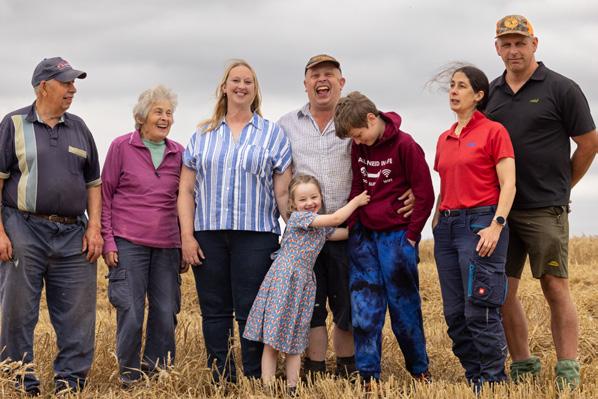
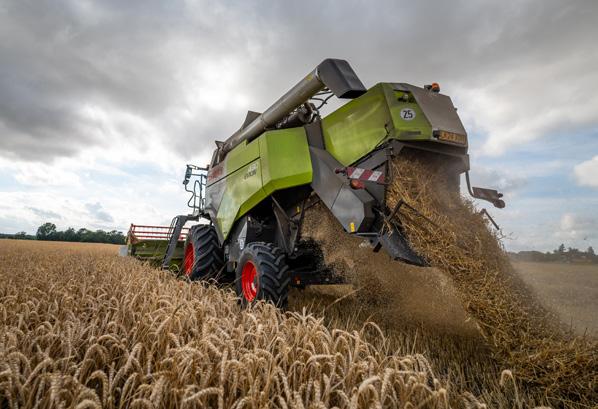
Despite being a totally new machine on paper we realised many of the internals of the EVION are time-proven designs from other CLAAS machines.
Richard Infield
“Almost more impressive than that is its fuel consumption. Because the engine is never loaded up beyond 70% swathing or chopping, by my rough calculations we’re now using around 40% less diesel for every tonne that lands in the bins.”
CAB AND CONTROLS
“Having come from a 22 year-old machine, the cab on the EVION is a complete revelation. It’s roomier and the visibility is so much better – a big safety factor on the road.
“But the highlight is how much quieter it is. By shifting the engine to behind the grain tank, CLAAS engineers have performed miracles – in truth you don’t know whether its running or not when you’re sitting in the seat.
“Having been used to mechanical levers sprouting from everywhere on the MEDION, the EVION touchscreen and armrest
switches are an absolute pleasure to work with. It doesn’t take long to figure out the computer and critically it means I’m much more inclined to tweak settings as I’m going along, keeping the combine running at its best.”
HEADER
“Being significantly wider than the older cutterbar I was expecting the EVION 6.2m CERIO header to slow up the pace a little but in truth we’re now covering the area faster than we were before.
“One of the best features of the new header is the ability to manually extend the table to handle taller crops – along with the extra reel travel it makes a huge difference to how well the crop feeds in.”
MAINTENANCE
“Shifting the engine back to behind the tank and having most of the drives down one side of the machine means everything stays so much cleaner than before. Having an on-board compressor means I can blow the rads out when required and I stay cleaner too!”
FINAL WORD
“When we set out to replace the old MEDION we wanted something more capable but also something we would be familiar with.
“The EVION matches that and more. It’s an exceptionally comfortable place to spend the day and we know that it’ll easily clear our acreage in good time ensuring we achieve milling premiums, produce quality home-grown feed and have minimal drying to do.”
New V-FLEX chopping cylinder
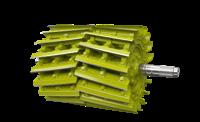
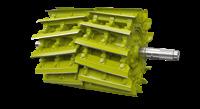


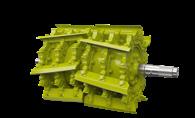
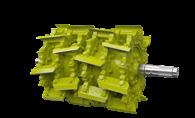
CLAAS has raised the bar even higher in terms of chopping quality, efficiency, reliability and comfort with the introduction of several new technologies for JAGUAR forage harvesters. JAGUAR customers can now take advantage of new options such as the V-FLEX chopping cylinder and CSPS analysis via CLAAS connect, as well as various improvements to the crop flow and drive provided as standard.
V-FLEX CHOPPING CYLINDER: MAXIMUM FLEXIBILITY, MINIMUM WEAR
Available as an optional alternative to the V-MAX chopping cylinder, the V-FLEX offers unrivalled versatility when it comes to knife configuration and sets new standards for smooth running and knife service life. In addition, it enables high throughputs and further enhanced chopping quality.
The new design with optimised V-angle and the new V-FLEX knives enable this chopping cylinder to achieve higher throughputs while at the same time reducing the noise level and ensuring smoother running. Crop flow is noticeably more consistent, especially for chop lengths over 12 mm. High knife stability and the triple bolted connection also means that the gap between the blade and the shear bar can be reduced to achieve even better chopping quality. All these improvements also deliver greater efficiency: with further reductions in fuel consumption per tonne of throughput.
The V-FLEX chopping cylinder is available in four versions with 20, 24, 28 and 36 knives and can be configured with a full, half or third set of knives to extend the length of cut, or with a half knife set. With the V-FLEX 36, for example, this enables a flexible configuration with 36 knives in full-knife mode, 12 knives in the one-third-knife mode, 18 knives in the half-knife mode or with the new variant with 36 half-knives to double the length of cut for optimum crop flow and outstanding chopping quality. The V-FLEX 20, 24, 28 and 36 therefore provide a unique, universal length-of-cut range from 3.5 to a maximum 53 mm.
LESS WEAR FOR LONGER OPERATING INTERVALS
The newly developed and patented knives on the V-FLEX chopping cylinder are angled at 10 degrees to the shear bar for outstanding precision and agility. The extended 23 mm thick anti-wear coating makes the knives extremely robust and wear-resistant in all conventional chopped forage crops. This significantly extends the service life of the knives based on throughput, which further optimises process costs in the forage harvesting chain for farmers and contractors.
Riveted accelerator paddles ensure uniform crop intake and the V-FLEX knives are fastened to the highly wear-resistant base with three bolts and corresponding clamps (half knives: two bolts and clamps per knife). The predefined position of the knives on the chopping cylinder makes for fast knife changes as there is no need to align the knives with the shear bar.
The JAGUAR also features a new knife sharpening operation to make it even more user-friendly. In addition to individual ‘knife sharpening’ and ‘individual shear bar adjustment’, operators can now select a combined knife sharpening and shear bar adjustment option completed in just one minute for pre-determined sharpening cycles – at the touch of a finger in CEBIS.
The sensor-based shear bar adjustment has also been optimised. A status display showing the process time, status description and visualised process is now available in CEBIS for all sequences. This enables operators to better estimate downtimes and make optimal use of waiting times. As before, the sharpening interval can be pre-programmed according to time or throughput based on the QUANTIMETER throughput readings.
Discover more >
V-FLEX 20
V-FLEX with half the full set of knives
V-FLEX with half section knives
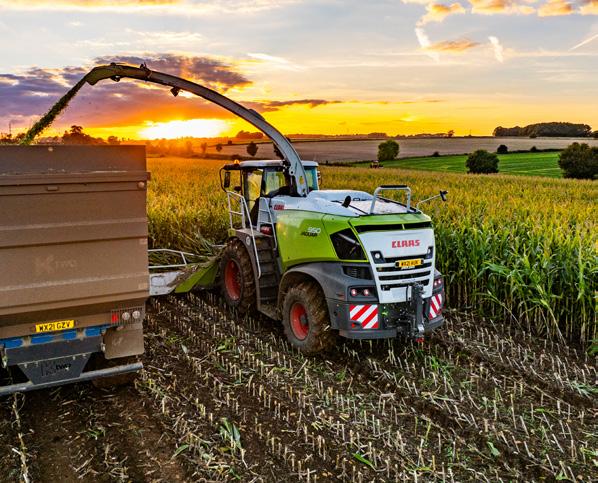
V-FLEX cylinder boosts knife life and performance
Over three seasons with the new V-FLEX chopping cylinder in a JAGUAR 950, Kidner Agricultural Contractors has experienced a major increase in knife life and improved performance.
Located near the Cotswolds, the team regularly encounters stones in their forage-harvesters, as many customers opt for multi-cut silage operations. Local limestone brash often ends up in swaths for the JAGUAR 950 and 970.
“With all the stone here, it’s a tough test for any forager,” says Matt Kidner. “CLAAS asked us to trial a cylinder more resistant to foreign objects, and we were eager – anything to reduce breakdowns and wear is welcome.”
The V-FLEX features flatter knives on a redesigned carrier secured with three bolts, allowing stones to pass through without damage.
“We’ve found it handles stones far better – damage is minimal,” Matt says. “The knives last longer without needing as much grinding, so we’ve only changed them once in 14,000 acres on the 950, compared to two and a half sets on the 970.”
Performance also improved immediately, with less engine drag and more consistent chop quality. Operator Josh Tuck adds, “The new
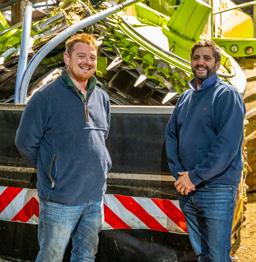
setup generates more blow and even crop feed, delivering more output and a better chop. We’re covering more acres with less downtime – the V-FLEX has been a game changer.”
Josh Tuck and Matt Kidner
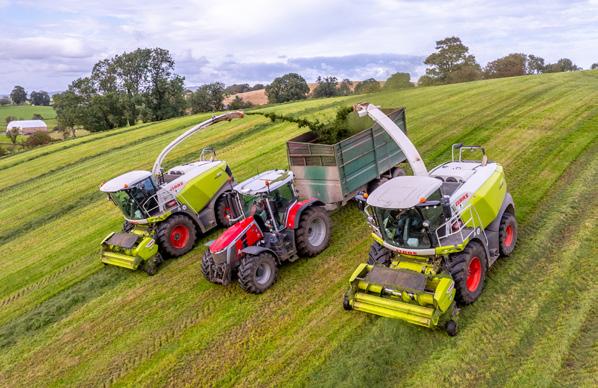
V-FLEX drums enhance reliability
In the Pennines, on the LancashireYorkshire border, the Long family operates three CLAAS JAGUAR forage harvesters, two with the new V-FLEX drums. Offered the chance to trial the V-FLEX cylinder three years ago, they found it ideal for their stony fields. Each knife in the V-FLEX drum is secured with three bolts, allowing blades to be knocked back by foreign objects without causing major damage.
“We’re always open to trying new equipment, and the V-FLEX drum promised reduced downtime and repair costs,” says Josh Long. Previously, with two harvesters running V-MAX drums, they faced up to four blow-ups each season due to stones, leading to time-consuming and expensive repairs. Their older V-CLASSIC drum in the 2012 JAGUAR 960 had less frequent issues, but the V-FLEX offers similar damage prevention with enhanced design improvements.
The Longs quickly noticed benefits with the V-FLEX drum. It generates less drag and offers more blow, improving performance. Their first blow-up on the new drum required only minor repairs—knife adjustments and replacing mounting segments—and had them running again in just an hour and a half. The same incident with a V-MAX drum would have taken at least a day to fix, forcing them to rely on backup equipment.
Convinced of the V-FLEX’s advantages, they ordered a new 970
with the same setup. Now, with two JAGUAR 970s and the older 960, their fleet is better equipped to handle the rocky terrain. The V-FLEX knives, flatter than V-MAX blades, also last longer. After covering 30,000 acres, they’ve only needed five sets of V-FLEX blades, compared to changing every 4,000–5,000 acres previously.
The V-FLEX drum’s design also minimizes wear on the blade bolts, allowing for bolt reuse. “CLAAS assured us the new bolts would hold up, and we haven’t seen any significant wear,” says Josh. This saves time and money, making blade changes just as efficient as with the V-MAX.
With three successful seasons behind them, the Long family plans to use V-FLEX cylinders on all future foragers, confident they provide reliable performance and peace of mind against mechanical damage from foreign objects.
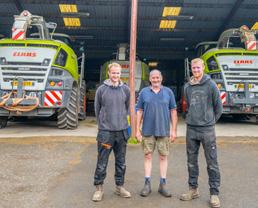
SILVER LINE parts – so your CLAAS remains an original CLAAS

THE SPARE PARTS RANGE FOR OLDER CLAAS MACHINES.
Regular maintenance and the timely replacement of wear parts are crucial for the operational reliability of harvesting machines and tractors. This is especially true for machines that have served you reliably for a number of years. With the SILVER LINE range of spare parts, CLAAS offers you an economical solution for repair and maintenance that is in keeping with your machine’s current value. We have developed SILVER LINE parts specially for older series and tested and approved them according to our high CLAAS standards. They offer proven CLAAS quality at a balanced price/performance ratio.
THE ADVANTAGES FOR YOU:
Original:
All parts are custom-made, reliable and efficient.
Appropriate: They are specially developed, tested and approved for older machines.
Economical:
Benefit from attractive conditions.
Available: All parts are available from your dealer and supported by professionally trained service personnel.
SILVER LINE is keeping our
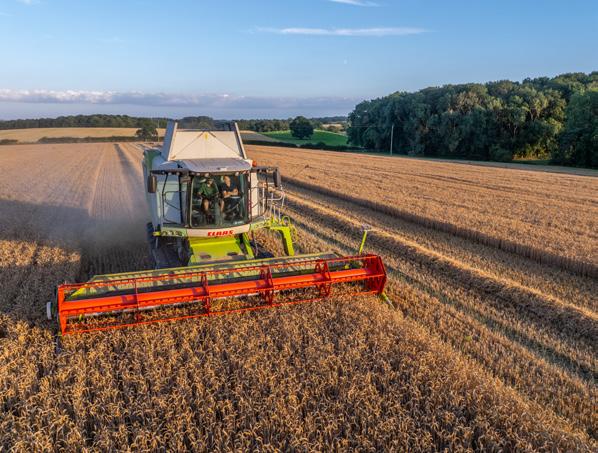
Running two foragers and six combines – all of varying vintages – Gordon and Jack Walker know all too well how essential thorough maintenance is to keep older machines running reliably through harvest.
Running two foragers and six combines – all of varying vintages – Gordon and Jack Walker know all too well how essential thorough maintenance is to keep older machines running reliably through harvest.
The business’ combines range in age from a 1997 straw walker LEXION 430 to a 2011 750 hybrid rotary. With a total contract cutting acreage of just over 1,000ha, each harvester’s individual workload isn’t particularly strenuous – they each average 150200 hours a year.
On the silage side there’s a 20-year-old JAGUAR 900 that’s done just shy of 8,000 hours and a 2009 Jaguar 960 that’s clocked 6,500 hours.
“We tend to run older combines and foragers that we can fix ourselves. Having had experience of driving and fixing different coloured combines and foragers, it’s only CLAAS harvesters that we have the confidence to run beyond the 5,000-hour mark.
“Having sensibly sized machines is essential when you’re dealing with small farms with small fields, small grain stores and small silage clamps. Because we’re not doing ridiculous acres with our machines and they’re well on top of the job, they’re not clocking silly hours which means we can get away with running older kit.
“Of course that means we have to be that much hotter on maintenance. Often it’s hard to justify replacing expensive components with genuine parts on older, lower value machines.” Frequently the cost of manufacturer-branded parts would make
Nick Fone
CLAAS machines genuine.

SILVER LINE parts have the same warranty on them that standard CLAAS spares have and you know they’ll be with you the next day.
Jack Walker, Harvest 2024
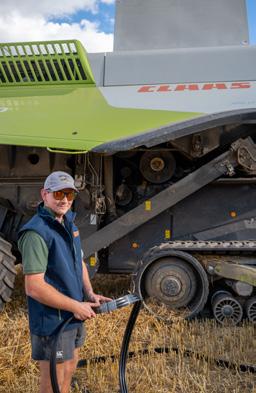
repairs uneconomic and so the Walkers would often have to opt for non-genuine spares. So when CLAAS introduced its SILVER LINE parts range designed for older machines with lighter annual workloads they were interested to see how the products measured up both in terms of cost and quality.
“With equivalent pricing to parts from non-genuine suppliers or sometimes less we were keen to try some key SILVER LINE bits.
“The first thing we bought was a main drive belt for the JAGUAR 960. When it arrived there was no obvious difference between it and a standard version and after a full season’s work it’s showing no signs of wear.
“That’s given us the confidence to use SILVER LINE parts on the combines too. It just makes sense - we have the benefit of having genuine CLAAS parts but without the expense we would have had previously.
“SILVER LINE parts have the same warranty on them that standard CLAAS spares have and you know they’ll be with you the next day. The big advantage is that by ordering through your local dealer you know their parts people can use the machine serial number to source the bits, ensuring you end up with the right parts first time round. That’s not always the case with other suppliers.
“At the end of the day these decisions nearly always come down to cost and we’re so pleased that we can now use genuine CLAAS parts for our machines. Running older harvesters you have to expect breakdowns but they also need to be affordable to fix. There’s a great sense of satisfaction in maintaining your own equipment and doing that with the parts that are the right ones for the job provides a great deal of peace of mind.”


The new ROLLANT 630 RC UNIWRAP marks a further development of the proven series, with the main focus of development being to provide more power, greater ease-of-use and lower running costs, combined with an even more rugged design for drive components subject to heavy wear.
ROLLANT 630 RC UNIWRAP
Feeding the new ROLLANT 630RC UNIWRAP is the latest generation pick-up, the 2.10m-wide CLAAS Multiflow, which is designed to reduce crop losses and ensure more uniform material crop flow into the baler. The standard pick-up is equipped with five cam-controlled tine bars. The new cam track reduces the power requirement by 20% and removable strips made from special plastic guarantee rapid and easy access for maintenance work.
Crop transfer into the baler is via the tried and tested heavy-duty ROTO CUT cutting rotor with 8 mm double tines made from doublehardened boron steel arranged in a helical formation. Four rows of tines feed the crop at up to 13,800 cuts per minute optionally through the 25-knife cutter bar with a 44 mm cut length. The knife groups (25/13/12/0) can be activated electro-hydraulically from the cab. All knives are individually secured and can be hydraulically engaged or retracted centrally.
The PRO cutting floor can be lowered by up to 30 mm to adjust the crop flow and prevent blockages in uneven swaths. An optical and acoustic early warning system additionally enables the driver to operate as close to maximum baler capacity and to reduce the ground speed when the forage volume increases significantly. Should a blockage nevertheless occur, the cutting floor can be lowered hydraulically by pressing a button on the control terminal.
BEEFED-UP DRIVES, CHASSIS AND TAILGATE SUSPENSION
The drive chains subject to the greatest wear have been substantially reinforced. The chain links there are both longer and stronger and together with larger gears, this reduces wear on the chains. Guides on either side of the chain-tensioning wheels also reduce wear by preventing the chain from slipping or shifting.
and satisfy demands for ever increasing bale weights, the frame has been redesigned, especially in the area of the tipping cradle. This also features new end-stop dampening to ensure rapid yet smooth operation.
Bale diameters are adjustable from 1.25 to 1.35m and the new ROLLANT 630 RC UNIWRAP can be optionally supplied with the MAXIMUM PRESSURE SYSTEM PLUS for even greater core compaction with the pressure fully adjustable from 60 to 120 bar from the cab.
RECORD WRAPPING TIME

Bale diameters are adjustable from 1.25 to 1.35m. The new ROLLANT 630 RC UNIWRAP can be optionally supplied with the MAXIMUM PRESSURE SYSTEM PLUS.
In addition to the normal central lubrication system, an enhanced PLUS central lubrication system which greases the complete wrapping table is optionally available and cuts maintenance time by a further 10 minutes.
To give the chassis more stability, especially in extreme harvesting conditions, in areas subject to the greatest wear the thickness of the steel has been increased by 20% to withstand extreme conditions such as a those associated with very wet crops.
In the chamber, the thickness of the drive shafts has been increased to 55 mm in areas subject to heavy wear to handle higher bale densities and the rear tailgate mounting has also been reinforced.
To give the chassis more stability in extreme harvesting conditions
Bales can be wrapped with either net or film for maximum versatility. One feature adopted from the UNIWRAP 400 is the impressive wrapping table, which further reduces film consumption thanks to a new hydraulic brake. With only 12 seconds from opening to closing the tailgate, the speed of bale transfer from the bale chamber to the wrapping table is unmatched. This is achieved by a special transfer geometry which returns the tailgate to its working position while bale transfer is still underway. The high-speed drive with up to 36 rpm significantly speeds up the subsequent wrapping process. It can wrap six layers of film with a 52% overlap in just 23 seconds. The new hydraulic film brake pre-stretches the film to an even greater degree to further increase efficiency: pre-stretching on the two 750 mm pre-stretchers can be adjusted to 67 or 82%.
SOIL-FRIENDLY
Large tyres up to 600/55 R 26.5 also set the ROLLANT 630 RC UNIWRAP apart from other baler-wrapper combinations. With a wheel diameter of up to 1.35 m, the baler is not only gentle on the soil and sward; it has excellent handling characteristics on the road and outstanding stability on slopes. Furthermore, the low centre of gravity supports bale transfer.
ISOBUS OR CEMIS OPERATION
The new ROLLANT 630 RC UNIWRAP is intuitively operated using the CEMIS 700 terminal featuring a 7-inch colour touchscreen with 10 direct access keys and a rotary push button. Alternatively, another suitable ISOBUS terminal can be used.
The CEMIS 100 terminal is provided at the rear specifically for operating the wrapper – enabling quick, simple direct access to all key functions.
Auger swathing option for DISCO 9300

Two swathing versions of the 9.10 m DISCO 9300 are now available. One, the DISCO 9300 C AUTO SWATHER, is a conventional mower conditioner with steel V conditioning tines and a belt swather. The second is a new straight mower, the DISCO 9300 DIRECT SWATHER, which incorporates an innovative auger system that can either be used to create a central swath or lifted to leave the crop spread over the full mower width.
DISCO 9300 DIRECT SWATHER – SPREADING WITHOUT A CONDITIONER
In creating the DISCO 9300 DIRECT SWATHER, CLAAS has redeveloped the tried and tested auger technology from the JAGUAR DIRECT DISC front attachment, which can be used in a number of different ways.
1. Both fully raised for full-width deposition for fast, effective wilting.
2. Both lowered to leave a central swathing for fast, effective field clearance without tedding and swathing.
3. 18 m mowing width consolidated to 12 m swath (combined swath/wide placement) for active control of wilting process and optimal forage harvester utilisation.
4. One raised, one lowered for one-sided swath laying when clearing the field margin.

By not having a conditioner, the DISCO 9300 DIRECT SWATHER can be operated with tractors from 180 hp, and early results indicate that the fuel consumption can be up to 40% lower than comparable equipment with conditioner.
TAPERED AUGER DESIGN
The two tapered augers are arranged close and parallel to the mowing discs to ensure consistent, reliable crop pick-up even when growth is uneven. The tapered design increases the feed volume towards the middle, as the increasing diameter of the auger enables more crop to be conveyed. The tapered auger housing has integrated ‘pockets’ in the rear to expand the available
DISCO 9300 WITH AUGER SWATHER OPTION


space, thereby significantly increasing the feed volume and thus the throughput. A shear bar and knives at the end of the augers prevents crop build-up and so guarantees blockage-free operation.
Swathing plates mounted on the central console guide the crop flow under the mower frame. Additional hydraulically pivoting and adjustable swath curtains prevent the crop being thrown out during one-sided swath laying. This ensures uniform swath formation under all conditions, maximising the efficiency of the downstream harvest chain.
Where the crop is to be spread for wilting, the top-mounted auger drive in the DISCO 9300 DIRECT SWATHER enables the augers to be swung open hydraulically at any time, allowing the crop to be deposited across the full mowing width. The augers can be conveniently swung open or shut individually or in parallel via ISOBUS – even while mowing is underway.
INTELLIGENT SUSPENSION
The standard ACTIVE FLOAT mower suspension can be adjusted to suit the harvest conditions via ISOBUS while mowing is underway. The optional CLAAS automatic slope control function regulates the ground pressure differently depending on whether you are mowing
up- or downhill to reduce side drag and so minimise misalignment between front and rear mowers.
For ultimate operator comfort, mower lifting is integrated directly into the tractor’s headland management system, while the mower’s load-sensing hydraulics are controlled directly via the ISOBUS on the tractor or the CEMIS 700 or CEMIS 1200 CLAAS ISOBUS terminals.
DISCO 9300 C AUTO SWATHER
The new DISCO 9300 C AUTO SWATHER uses a conventional steel tine conditioner to pick up the mown crop behind the mowing discs and feed it to the cross conveyor belts. Although this has a higher power requirement, it guarantees reliable crop flow in all crops, even under challenging conditions.
The new drive train in the DISCO 9300 C AS offers even greater throughput and operational reliability – with approval for tractors with outputs of over 400 hp. The use of high-quality Hardox components on the conditioner has further improved wear protection and at the same time reduced weight. The design of the cross conveyor belts has been optimised by switching to laser welding to reduce weight and fitting four lower supports to the AUTO SWATHER belt units to maximise stability in continuous use with heavy crops. New drive rollers for the cross conveyor belts have reduced the noise level.
SMART MOWING: AUTOMATION FOR MULTIPLE APPLICATIONS
The SMART MOWING intelligent control concept enables the front mower controls to be integrated into the ISOBUS of the rear combination, or the whole mower combination to be operated via the tractor’s headland management system – whichever the operator prefers. Furthermore, the DISCO 9300 C AS offers unique features such as automatic BELT BOOST acceleration to clear the belt units at the headland, automatic belt speed reduction for onesided lifting and automatic lifting of the mower units when shifting to reverse. The optional CLAAS automatic slope control regulates the belt speed and ground pressure when working on slopes to ensure optimum swath formation and sward protection while minimising drift.
Five new DISCO large-scale mowers
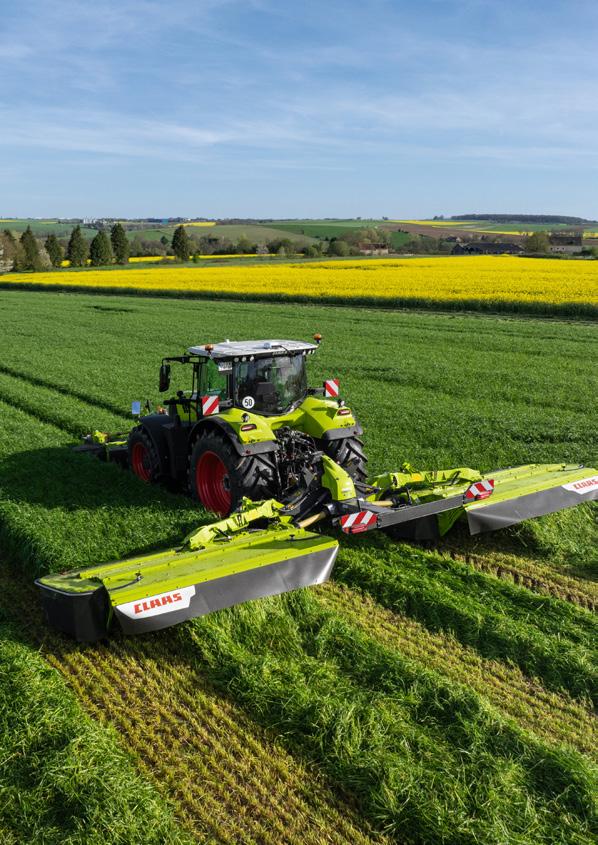
DISCO large-scale mowers have been setting standards for area output, durability and efficiency for 25 years. To mark the anniversary year, four new mowerconditioner combinations – the DISCO 8500 C TREND, DISCO 8500 RC TREND, DISCO 9300 C COMFORT and DISCO 9300 RC COMFORT have been introduced along with a straight mower - the DISCO 1100 COMFORT.
FIVE NEW DISCO LARGE-SCALE MOWERS
THE DISCO 8500 C / RC TREND
With the launch of the two new entry models – the DISCO 8500 C TREND and 8500 RC TREND – CLAAS has brought tried and tested features of the larger models to the smaller working widths which are suitable for use with tractors of 160hp and above.
The new DISCO 8500 TREND has a working width of 8.30 m and features a stable lightweight construction with a centre of gravity close to the tractor and a low rotational and tractive power requirement. The basic specification includes the proven, extremely robust telescopic arm concept with optimised centre of gravity, ACTIVE FLOAT ground pressure adjustment actuated from the cab and the fast-acting mechanical non-stop collision protection with auto reset.
The DISCO 8500 TREND can be operated at 850 rpm and features state-of-the-art drive technology with individual drive protection for each mowing unit and the latest bolted Walterscheid overload clutches. Hardox-reinforcement of the conditioner plate has made it even more resistant to wear and stone chips while providing an additional weight saving. Doing away with the LS hydraulic blocks and hydraulic collision protection has achieved further weight savings and significantly reduced the purchase cost.
As an option, the DISCO 8500 RC TREND with roller conditioner can be fitted with the double roller drive with innovative scissor gear unit first introduced in the DISCO 9700 RC AUTO SWATHER in 2023. This feature enables maximum throughput and service life even under demanding conditions in crops with high to very high growth.
The mowers are controlled via the two tractor spool valves and operation is even easier when integrated into the tractor’s existing headland management system.
DISCO 9300 C / RC COMFORT
The 9.10 m DISCO 9300 C COMFORT and 9300 RC COMFORT mower conditioners are built around a frame with optimised centre of gravity, with arms inclined to the rear. They can be operated with a reduced PTO start-up speed of 850 rpm and suitable for use with lighter four-cylinder tractors from 180 hp.
The V-shaped steel tines on the DISCO 9300 C COMFORT are designed to ensure even higher throughputs at reduced fuel consumption and also features Hardox-reinforced conditioning plates for maximum durability.
As on the DISCO 8500 TREND, the DISCO 9300 RC COMFORT can be optionally equipped with the double roller drive with innovative scissor gear unit. Longer swathing plates are also available to lay the crop in the narrowest possible swath.
A key advantage of the DISCO COMFORT is the optional automatic control of the ACTIVE FLOAT system. When working on slopes, the ground pressure – a key factor determining forage quality, sward protection, power requirement and slope safety – can be individually adjusted on each side using the optional automatic slope system. This eases the driver’s workload and ensures consistently high results at all times. Additional functions controlled by ISOBUS include individual lifting of the telescopic arms and optional hydraulic protective cover folding.

DISCO 1100 COMFORT
The new DISCO 1100 COMFORT uniquely combines a large working width with compact transport dimensions. The working width has been extended to 10.80 m by increasing the arm’s adjustment range by 10 cm. The working width can be infinitely reduced hydraulically to 9.60 m, and the two arms can be adjusted independently or synchronously. In combination with the DISCO 3600 front mower, this ensures optimal overlap at all times on tight bends or when working on slopes. Despite its width, the mower folds to a height of less than 4.00 m for road transport.
Operation couldn’t be simpler thanks to the COMFORT hydraulic controls from the DISCO 9700 and 1010; no separate control unit is needed. Lifting and lowering of the arms and adjustment of the working width are controlled hydraulically, or automatically using the programmable headland management system, while hydraulic protective cover folding and ACTIVE FLOAT ground pressure can be conveniently controlled either by the programmable F keys on the CMOTION control lever or by ISOBUS. The automatic slope control function is optionally available for convenient adjustment of ACTIVE FLOAT ground pressure and arm position.
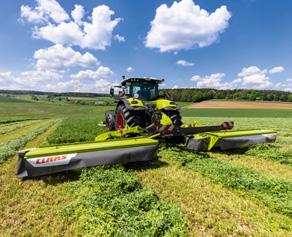
DISCO 9300C COMFORT pre-series
A straightforward, clean cutting mower
Ahead of the launch of the new range of DISCO 1100, 9300 and 8500 mowers, Metcalfe Farms has been running a pre-series DISCO 9300C COMFORT during the last foraging season.
The new 9.10m-wide DISCO was mainly working alongside their DISCO 9200C BUSINESS, which between them have cut around 3,200 ha, and replaced another DISCO 9200C BUSINESS.
Ben Hutchinson was one of the regular operators of the new DISCO 9300, and has been impressed with how easy the mower is to set-up and use. “The COMFORT specification is certainly not a backward step compared to the BUSINESS specification we would normally use. It was very easy to set-up and the hydraulics are extremely straightforward, literally one pipe for the left wing and one for the right; it couldn’t be simpler.
“The new screen layout is far better – it’s both simpler and clearer so easy to programme and use. I would reckon on comfortably maintaining a steady 8 ha an hour and certainly knock down around 80 ha a day.”
However, it is the small things that have been updated on the mower which, as an operator, he finds help make the DISCO very user-friendly. “The blade box is in a far better position right
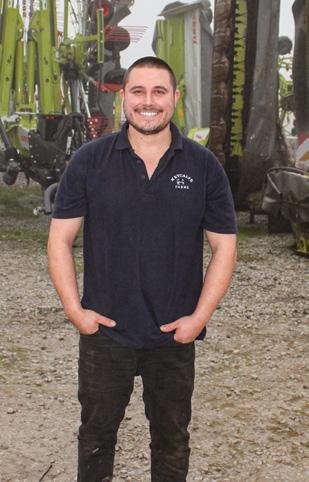

on the back of the mower where you want it, and it’s things like having a drain hole so water does not hold in the box meaning the blades are not rusty before they have even been used, and having space to store the worn blades. The Quick Change has always been good and having the different colours again just helps save time when swapping blades.
“Also the hydraulic pipe holder is in a far better position and right where you need it when taking the mower off. In addition, the (Hardox reinforced) hood above the conditioner is far tougher and there are no dents at all where stones have hit it compared to the other mower, plus the darker covers don’t show the dirt as much so it looks cleaner.
“Overall we have got on really well with it. It’s simple, straightforward and easy to operate, even in small fields. Whether we are in lighter silage or heavy crops for digesters, it just eats the crop.
“Also the ACTIVE FLOAT system makes it very easy to alter the ground pressure on the move, which is important especially where we are multi-cutting every 30 days as you do not want to scalp the swath and need to be more gentle. The (MAX CUT) bed has always been hard wearing and its simple to change the oil. It is noticeable how good and clean a stubble the DISCO leaves, especially when we are working alongside other makes of mower some of which leave a dreadful finish,” he concludes.

New 13 and 15m wide VOLTO tedders
Two new VOLTO tedders have been introduced that incorporate numerous innovative features, both of which are available with a self-steering chassis.
Until now, CLAAS VOLTO tedders have only been available in working widths from 4.5 to 13 m. The two new models, the VOLTO 1300T/TS and the 1500T/TS take this a stage further with working widths of 13 and 15.1 m respectively.
To handle the weight of grass flowing through the tedder at these widths, they feature a new frame and chassis concept combined with optimal ground-contour following and soil protection, very simple operation and folding geometry, optimised rotor guidance in the form of multi-functional XXL chassis/guide wheels with a diameter of 1,050 m, and a completely re-engineered, stronger PERMALINK drive.
The slender central frame with innovative Y-axle beam and individual wheel suspension combines several advantages: the long swing arm in relation to the rotor frame achieves unrivalled ground clearance during lifting. Yet the rotor frame’s centre of gravity remains close to the axles, ensuring maximum stability at the headland –even on uneven ground.
The wide axle with large tyres minimises rolling movements when the rotor frame is raised and ensures smooth, safe road travel. The compact length and height improve visibility to the rear and make it easier to negotiate tight bends and narrow spaces in the yard, machinery shed or field.
SELF-STEERING AXLE
The TS versions of the VOLTO 1300 and VOLTO 1500 are equipped with a unique self-steering chassis for easy manoeuvrability without lifting the rotors. It also prevents distortion between the chassis and rotor frames, as well as damage to the sward caused by the rotor wheels. When the rotor frame is raised, the chassis wheels automatically align in the direction of travel.
Tyre sizes from standard 15/70-18 to optional 500/55-20 with 1,055 mm diameter guarantee soil-friendly driving and tedding on grassland with the rotor frame raised on grassland and safe road travel even at higher speeds. The chassis wheels are multifunctional, also serving as guide wheels and effectively preventing the rotor tines from sinking into the soil.
NEW PERMALINK DRIVE
As with all VOLTO tedders, these two new additions feature the tried and tested MAX SPREAD spreader arms angled at 29.3°. The VOLTO 1300 T/TS has 12 rotors, each with a 1.5 m diameter and six spreading arms, while the VOLTO 1500 T/TS has 14 rotors of the same design. The spreading angle can be adjusted from 12 to 16 degrees on the rotors without tools, while a crank handle on the left of the chassis frame provides central adjustment of the raking height. A scale on the lifting ram support acts as a guide. A hydraulically operated edge-tedding crop guard is optionally available.
The PERMALINK drive has been completely re-engineered and subjected to several thousand hours of testing both in the field and on the test rig for maximum reliability. The completely redesigned PERMALINK HD finger clutch and modular, oil-filled rotor drives are the stand-out features that set it apart from other drives on the market. The shaft speed has been increased by 50 per cent to reduce the torque on the drive shafts. At the same time, the finger clutches have been reinforced and fitted with new, larger bearings. As before, they enable 180-degree folding with full power transmission. In addition, the rotors have been given new encapsulated drives, extending maintenance intervals to several years. Both tedders fold down to a width of just under 3.00 m with an overall height of 3.29 m. No terminal is needed and a single-acting spool valve controls the lift ram, while a double-acting one controls folding and unfolding of the rotor frame.
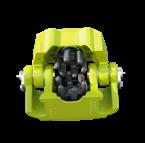
VOLTO 1500 pre-series
VOLTO 1500 impresses
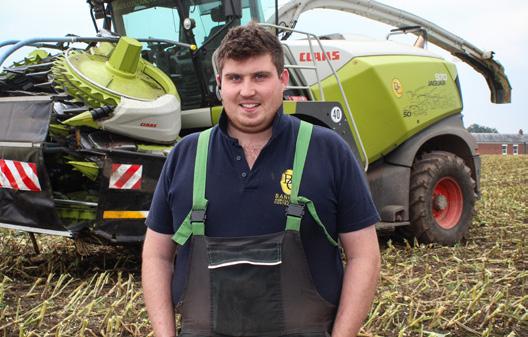
Ahead of the launch of the new VOLTO 1300 and 1500, Banks’ Contractors in Shropshire has been putting a preseries 15.1m wide VOLTO 1500T through its paces and been extremely impressed with what they have seen.
Until now, Banks’ has relied on two VOLTO 1300 tedders to work behind their three DISCO 9300 mowers, routinely spreading all the 1,600ha of first cut silage, in addition to around 800ha of haylage and 200ha of hay.
Looking to increase outputs, especially in silage ahead of their two JAGUAR 970 foragers, Banks’ jumped at the opportunity to assess the new VOLTO 1500, and in this respect it has more than met the bill, covering about 12ha an hour compared to 8ha with the smaller VOLTO.
But for Jack Banks the two things that really stand out on the new VOLTO are the build quality and strength of the new VOLTO, along with the reduction in PTO speed to 540rpm and the impact this has had on overall reliability.
“In all respects the new VOLTO is a totally different machine,” he says. “It’s more reliable so cheaper to run, uses less fuel yet covers more ground. It’s doing the same amount of work as our 1300’s but in about half the time.
“There’s a lot more steel in the frame and drives on the new VOLTO. Also the new design means that more weight is now carried on the tractor linkage, which takes all the weight off the frame and the rotor support wheels, which again helps reliability.
“The reduction in PTO speed to 540rpm is a great improvement and makes a big difference. With our old VOLTO, due to the amount of material that was passing through them and because they were under so much strain running at 1,000rpm, this did have an impact on wear and tear.
“Because the new VOLTO 1500 now runs at a slower speed and not running flat out, not only is fuel use lower but there is far less strain on the drives and frame, plus we have not lost a single tine. We have also noticed it is more gentle on the crop and the spread is far more even, especially in hay, which has also been commented on by customers.”
Other new features that meet with Jack’s approval are the new height adjuster, which he says is far better and because you are now stood at the rear of the tedder, it’s far easier to see and alter the clearance. In addition, the redesigned folding system means the VOLTO folds down tighter making it far more compact for transport.
“The new VOLTO 1500 is a far better tedder and done all that we wanted and more. You look at this VOLTO now and you can see the difference. Reliability has been excellent and we have not had to touch it. I am sure that a second will now be on the list to replace the other VOLTO 1300 for next season.”
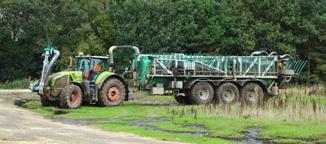
Well matched combination

From an initial idea discussed over a pint in the pub in 2007, GWE Biogas has developed and grown to one of the largest biogas plants in the UK, generating over 9MW per hour of gas and electricity into the National Grid and most recently capturing carbon for food grade CO2.
Of its six digesters, three are powered from food waste with the other three using a maize, rye, wholecrop oat and chicken muck substrate, all of which is pasteurised for 60 minutes and on a 60day retention cycle.
Responsible for handling up to 150,000m3 of digestate are two AXION tractors, a 410hp AXION 950 that is paired with a Samson 31m3 tanker bought in 2019, these were joined last year by a 445hp AXION 960 with a Samson 36m3 tanker, both fitted with 36m dribble bar booms, and all bought through CLAAS EASTERN.
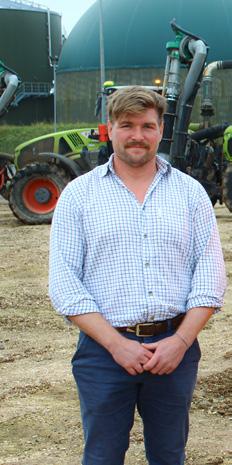
“We were initially running a different tractor and tanker combination, but saw the Samson tanker at Agritechnica and liked the look of it, particularly the 36m booms,” explains Frank Shepherdson, who has been with GWE since 2014 and initially operated the AXION 950 before changing to the 960 when it arrived. “It was the same time that EASTERN took on the franchise, so we arranged a demo of a 20m3 machine and liked it a lot, but it was far too small as we need the bigger tankers so as to take a wagon load in one fill.
“So as to keep everything within one dealership, Tom (Megginson, owner of GWE Biogas) asked me what I thought about having a CLAAS tractor. I was not convinced as I loved the tractor I had, but we had a 950 on demo for two weeks and I really liked it.
FANTASTIC COMFORT
“The comfort is fantastic. I have just been driving another tractor we borrowed and could not get comfortable. I have always had a bad back, but even after 12 hours in the AXION I am fine. It’s great to drive; everything in the cab is where you want it and they have been really reliable. The 950 has now done around 8,000 hours and they have not been easy hours as the tractor is always operating at PTO speed and pulling a lot of weight. Fully loaded the 950 is pulling 68 tonnes and the 960 pulls 74 tonnes.”

“The AXION just turns up and does the job,” adds Dan Cole who operates the 950 and also used to drive one in New Zealand. “It’s very manoeuvrable, easy to use and the tractor and tanker are well matched.”
Spreading on farms over a 30 mile radius, during the season from January to October, Frank will cover over 3,800ha and Dan around 1,000ha. On each of the tractors, the tanker’s filling arm has been relocated to the front of the tractor, which makes it easy to fill either direct from lorries, cones or from tanks. The most recent tanker is also fitted with NIR sensing analysing the NPK and dry matter, and they also make use of TELEMATICS for data logging, fuel use and general performance information.
GOOD SPREAD OF WEIGHT OVER FIVE AXLES
“The tractor and tanker combination has the advantage over a self-propelled machine in that the weight is spread over five axles,” explains Commercial Manager James Short. “We do a lot of spreading during the spring into crops, even as late as June applying a protein dressing. To spread the weight, a selfpropelled machine will typically be on 900 tyres, which is no good for tramlines, whereas we are on 710’s on the tractor and 710 and 800s on the tankers.”
Applying up to 1,400m3 in a really good day, one of the best features of the AXION for Frank is the combination of the 8.7 litre FPT engine with the CMATIC continuously variable transmission. “I can’t fault it,” he says. “The combination is brilliant and ideal for the job. The transmission is very smooth and I have never had any issues.
“Because the tractor is always doing the same job, once it’s set up I don’t change the CEBIS settings much, but I use the CRUISE Control function all the time so as to maintain a constant 12 or 16kph. I also have the forward speed, engine speed, PTO and steering set up on the headland management, but not the pump on the tanker, as that has to be engaged earlier because it takes so long for the liquid to come through.”
“I can’t fault the AXION,” adds James. “They have been brilliant and that was the main reason we went for a second, combined with the service and support we get from CLAAS EASTERN. The whole team at Catfoss are fantastic. They are very good at communicating with you and keeping us informed, but in the five years we have been using them, the longest wait has been three hours. They do a very good job, their knowledge is superb and they are more than willing to give advice.”
Left to right: James Short, Frank Shepherdson and Dan Cole.
From fields to finish lines
How George Pickering transformed a family farm into a world-class dirt racing destination.
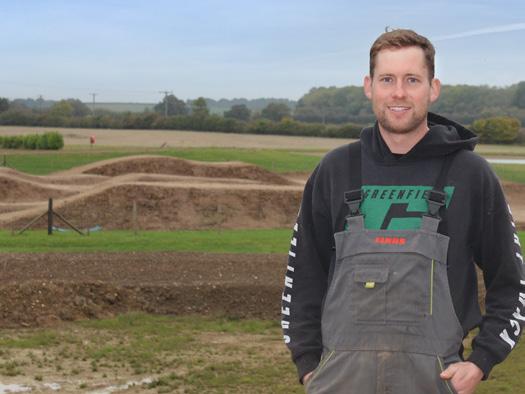
Farm diversification can take many forms. In George Pickering’s case it has seen him progress from racing motor bikes as a teenager to developing the internationally recognised Greenfield Dirt Track on his farm in Lincolnshire.
“As a kid my father created a track of sorts on a bit of poor ground on the farm that we would maintain just using a set of chain harrows behind a quad bike. Each year we would develop it a bit more and learn how to prepare it to a better standard, so I started letting friends use it and it has developed from there,” explains George who farms 240ha at Aby near Alford, in addition to arable contracting over a further 200ha and running a fleet of eight lorries.
It was in 2012, having experienced the often poor standards on tracks that he visited, that George felt that he could do better and that there was the potential to create a viable, high standard track on the farm, with the first race meeting held in 2016.
THREE PERMANENT RACE TRACKS
Today the farm is home to three permanent tracks; a 300m long Flat track, a 1,600m Motocross track and a kids track. Plus during the winter he creates what he calls a Stubblecross track in a 8ha field of overwintered spring barley stubble using a Discordon.
In addition to hosting 20 recreational practice days a year, attracting around 100 riders a day, the track also now hosts five major race meetings in which there will typically be up to 70 races held on the Flat track, with 12 riders completing 6 lap races or on the Motocross where riders compete in races that last for about 15 minutes, and there will be a total of around 18 races per day. These meetings will see up to 200 riders competing, not only from the UK, but also Europe and Scandinavia, and even from the USA where for some it has become a ‘bucket list’ item to compete on the track.
THE CLAAS APPROACH TO TRACK MAINTENANCE
“Preparation is the key to our reputation, and it has taken about eight years to reach the stage where we are at now. Myself and the other two lads that work on the farm, who help me prep the track, can trust ourselves and not feel too stressed about our decisions on how the tracks need to be prepared to create the optimum consistent racing conditions for the 100s of riders and 1,000s of laps,” states George.
How he prepares the tracks ahead of a meeting is determined by the weather and soil conditions, combined with their experience built up over the years. Typically, immediately after a meeting on the Motocross track they will go through with a flat lift and then power harrow the track, while for the Flat track, because it does not get rutted, this just needs levelling with a Dutch harrow and chain harrowing. Then ahead of a meeting they will go through again to prepare the surface and water accordingly.
To meet the widely differing needs, George has built up an array of implements that are used behind the farm’s three CLAAS
tractors – an 18-month old ARION 660 CMATIC, a ’71 plate AXION 850 and a back-up 2008 ARES 816. He also runs a TRION 650 combine and SCORPION telehander, all sourced through nearby CLAAS EASTERN at Ulceby Cross.
The farm is also home to a CLAAS Challenger bought by George’s grandfather in 1999, which he says will never leave the farm. “It’s done about 12,000 hours and is semi-retired but it still comes out for cultivations as we all love driving it, plus on race days we will use it between races with a Dutch harrow or power harrow on the Flat track, more to keep the spectators happy as they love seeing it.”
A key element in the track preparation is the need to water the tracks to achieve the optimum riding surface and avoid dust. While he uses a vacuum tanker for the Motorcross track, for the Flat track the team have adapted an old Chafer 4,000 litre sprayer that enables them to apply up to 4,000 litres of water in one lap of the track, operating at 2-bar over a 12m spraying width and running at 3kph.
CONSISTENCY IS KEY
“In a Flat track race you will have 12 riders competing, so it is important that the course condition is consistently the same across the full width and length of the course for each rider,”
CLAAS AXION & ARION
says George. “The sprayer came with a 600 litre capacity pump and 24m booms, so to achieve the application rates we required we added another 600 litre pump and a second 24m aluminium spray line and the booms are only folded out to 12 metres.
“To handle this, both the AXION and ARION have been specified with the highest possible hydraulic systems. This is now the fourth AXION 850 we have had and it’s great to see how the tractor has evolved and keeps improving.
“With the new ARION I also went for the CMATIC transmission. I have been that impressed by it that I will certainly specify that into the build of our next track. It’s ideal for watering the Flat track because having set the speed required it will keep exactly to that. Using it on the Motorcross, I can run the tractor at just 1kph so as to apply 100,000 litres of water over the length of the track, which is normally the amount required in the summer season.
“The ability within CEBIS to also easily change the settings such as the hydraulic flow is very useful. When using the sprayer I have it set so that one of the pumps has the priority and then alter the flow rate for the second so as to give me the flexibility to alter the flow rate according to the conditions.”





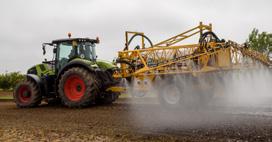
First in Ireland: AXION 960
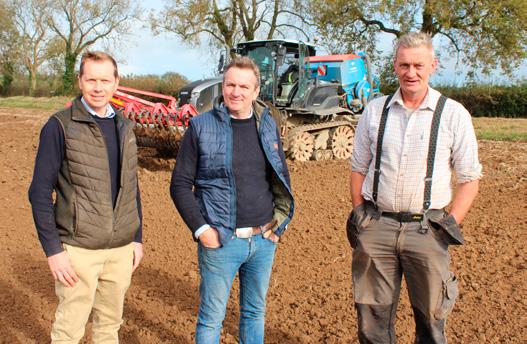

Left to right: Noel and Mark Sheridan and Derrie Donegan.
TT boosts efficiency
‘A tractor with tracks that drives like a tractor, rather than a tracked tractor’ is how Mark Sheridan describes the
AXION 960TT, which is the first to be sold in Ireland.
The arrival in April of the 445hp AXION TT on the 800ha he and his cousin Noel farm in Co Meath, trading as J&C Sheridan (Kilberry) Ltd, is the culmination of nearly two years of research on the tractor to determine its suitability for their farming system. This included visiting users in the UK and also the CLAAS UK headquarters at Saxham, but no final decision was made until LEINSTER FARM MACHINES arranged for them to have one on demonstration in their own fields and conditions this spring.
“Typically a farmer in the UK would be using the AXION TT as a heavy cultivations or drilling tractor pulling large trailed implements, whereas we run a system based around threepoint linkage mounted PTO driven equipment,” says Mark. “Because we grow potatoes, our arable system is based around a plough and combination drill, so we needed to satisfy ourselves that the AXION would fit in with our system and what we are looking to achieve in the future, while also providing the compaction benefits, clearance and reduced transport width for roadwork, that we were looking for.”
a tracked tractor, and it drives like a tractor. It’s very hard to compare to the other offerings, but it all adds to our operation,” states Mark. “We are also very comfortable with CLAAS tracks, having experienced them on our Grimme harvesters since 2009 and more recently on our LEXION combines.
“The footprint from the tracks is considerably larger than from the duals, and it stays up and pulls through wet spots extremely well. I am looking forward to spreading with it as the 735mm wide tracks also fit in very well there. With a wheeled tractor, to get anywhere near the footprint, you would have to go to 900-wide tyres which are just not suitable for row work. All day long tracks are always going to be far better for reducing compaction.”
The AXION TT is a unique offering and while we also considered four other machines, they can’t do what the AXION does.
Noel Sheridan
The AXION 960TT replaced a 290hp tractor that was mainly fitted with duals so as to reduce compaction. This, however, did restrict its use to certain operations and also made moving the tractor around local roads difficult.
“The AXION TT is a unique offering in that it behaves like a conventional tractor and when in it you would not know that it has tracks. When we drove one on the track at Saxham and then drove a wheeled AXION, you could not tell the difference. There is not the problem of scuffing on the headland, its extremely versatile, compact and safe,” states Noel Sheridan.
Main jobs that the AXION inherited from their previous tractor are bedforming using a 5.4m wide, 3-bed rotavator ridger, powering a 6.0m Lemken Solitair combination drill with furrow press and pulling a chaser bin. However, due to its compact size and greater versatility, having made a move from 30m up to 36m tramlines, the AXION will also take on fertiliser spreading using a five tonne capacity spreader.
“While we did also consider four other machines, they can’t do what the AXION does. We definitely wanted a tractor, not
“The window of opportunity to get jobs done is getting narrower. This spring was very wet and conditions were far from perfect,” adds Noel. “Generally we are having to keep the main tyres on for spreading and spraying longer before changing. For later top dressing the tracks may take out a couple of rows, but that’s a small price for what we gain by going to a wider tramline width, and the steady platform that the tracks provide for spreading at that width. Likewise the stability and large footprint of the tracks make them a very good, stable platform when ridging. With the old tractor, at times the ridger was controlling the tractor, but with the AXION it is definitely in charge.
“The ride comfort is incredible, especially for higher speed jobs such as pulling the chaser bin. The tracks also mean that its incredibly stable on the road. A lot of our implements are high folding, so the centre of balance is higher, but you get no swaying on the road which you would with tyres, especially if they are running at a lower pressure.”
The new AXION TT is mainly operated by Derrie Donegan. Being the first CLAAS tractor he has driven, while used to the CEBIS terminal from driving one of the farm’s LEXION 8700TT and LEXION 760TT, he admits that it initially took him a bit of time to get used to the CMOTION controller and CEMIS 1200 GPS PILOT screen, but now finds it very easy to navigate around the screen and set-up his AB lines.
“The tracks do a great job and the ride comfort is fantastic; the combination of the front axle, track and seat suspension makes it so smooth,” says Derrie. “The tractor’s greater power means that even when I am working at 15 to 17cm after spuds it has the power for the power harrow to fully work down the ground and leave a good tilth with power to spare, whereas with the old tractor you could often still see wheelings. Also it just rides over any wet spots, so avoids the need to lift the implement or drill a bit to avoid getting bogged down.”
New 3- and 4-tonne SCORPION
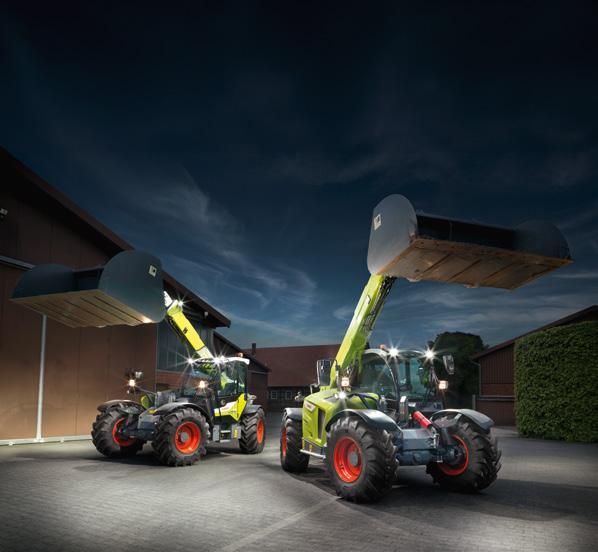
Five new 3- and 4-tonne capacity telehandlers, the SCORPION 733, 1033, 638, 738 and 742, have been introduced which feature significant improvements in comfort and convenience, as well as improved stability and more lift capacity. In addition, there is also the option of the new VARIPOWER 3 drive with boosted tractive force on the SCORPION 738 and 742.
MORE CLEVER, STABLE AND STRONGER THAN EVER
Thanks to higher hydraulic pressure, the new SCORPION telehandlers deliver up to 300 kg more lift capacity – 3.3 t in the 1033 and 733 entry models and 4.2 t in the SCORPION 742. At the same time, to ensure the customary balance and stability, the wheelbase has been increased by 100 mm, with corresponding modifications to the counterweight at the rear.
They also benefit from new SMART LOADING functions too, thanks to new hydraulic controls with electronic pilot control. The following automatic functions and assistance systems are now available:
• Automatic bucket return to the previously saved position: saving significant time and effort when performing repetitive tasks close to the ground.
• Automatic bucket shake function: the tilt rams ensure reliable emptying of clumping materials and even distribution of loose materials.
• Automatic retraction of the telescopic arm (not for SCORPION 1033): the mast automatically retracts as the telescopic arm is lowered – significantly reducing the operator’s workload. Power comes from a 143 hp, 550 Nm Liebherr 4-cylinder diesel engine with a hydraulic output 160 l/m at a quiet and fuel-efficient 1,600 rpm. During loading, DYNAMIC POWER automatically adjusts the engine speed to the joystick angle and so to the desired lift and loading speed. This unique feature ensures faster, even more efficient load cycles.
NEW MORE POWERFUL VARIPOWER 3 TRANSMISSION
In place of the standard VARIPOWER 2 transmission, on the SCORPION 738 and 742 models there is the option of the new VARIPOWER 3. Thanks to its larger dual hydraulic motor, this transfers up to 68 kN tractive force to the wheels – an increase of around 20 per cent compared with the 57kN generated by the VARIPOWER 2.
FOCUS ON THE OPERATOR
The height and angle of the redesigned steering column is fully adjustable to perfectly accommodate the operator’s needs. The display is now positioned above the steering wheel, making it easier to read. To the right of the steering wheel is a 3.5-inch colour screen (optional 7-inch screen). In front is a handy smart phone shelf and to the left, the new control unit for the heating and air conditioning
system. The temperature and now the fan too can be adjusted continuously instead of incrementally in three stages and there is a new, larger air conditioning unit.
The joystick and other key controls such as the controller for the speed ranges now move with the operator’s seat, allowing the right arm to remain comfortably on the armrest during load cycles. In addition there is an extra LED headlight on the left-hand A pillar with ‘Coming Home’ function.
Another new feature is the pressure relief button on the left of the rear light bracket to de-pressurise the rear connections. Models fitted with air brakes have a connection for an air blow gun by the cab step and, a brush and shovel holder can be factory-fitted at the rear on the left-hand side for carrying up to two items. On the opposite side, there is room for a removable 5 l water tank for quick on-site hand-washing.
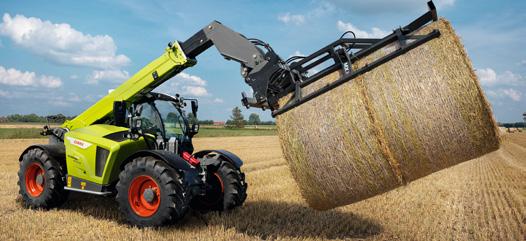
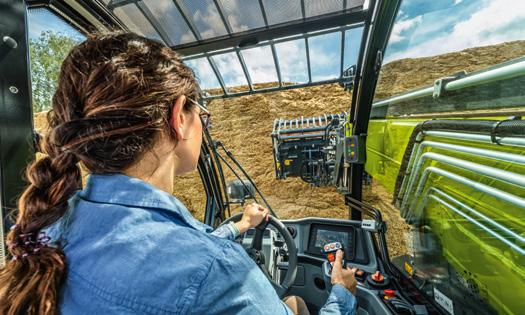

Exceeding expectations
Supplying a wide range of garden and landscape products, soils, aggregates and composts, the ability to quickly and efficiently handle and load materials is essential to the smooth running of Neil Gaunt’s business, Riverside Quarry Ltd.
Based on a 2.4ha site on the edge of Knaresborough, in addition to needing to load customers lorries and trailers, Riverside also runs a fleet of seven trucks, delivering to sites all over Yorkshire and further afield.
“The phones and broadband could go down, and while inconvenient, this would not stop the business,” says Neil, who runs the family business with his daughter Holly and son-in-law James Genders. “However, if we can’t handle or load materials onto lorries, then I don’t have any business. Our reputation is built on being a family business that provides excellent service and delivering when we say we will deliver. There is no quicker way of losing that reputation than by deliveries being late and the customer having a team of guys doing nothing waiting for you.”
Responsibility for ensuring that reputation is maintained is down to two SCORPION telescopic handlers – one a ’22 plate 756 and the second, a 746 Generation 2 delivered in early October.
“The SCORPION is absolutely fantastic – they have really superseded my expectations,” states Neil. “The biggest thing for me is the engine power and pushing power which a construction spec machine would not have – they are basically just a glorified wheelbarrow. But what impresses me most is the service we get from CLAAS EASTERN, which is superb.”
The new SCORPION 746 is the fourth SCORPION to be operated by the company. “The first was a used machine that I bought on the suggestion of James, who joined me having worked for a farming company and said how good CLAAS machines are and that I should try one. That was then replaced by a 2017 SCORPION 7044 I bought with 1,500 hours on the clock and has just been replaced after 9,500 hours by the new 746, next, there was the 756 in 2022.
“I also like the fact that the SCORPION is a heavy machine, so is very stable which is what you want when you have 2.5 tonnes of Type 1 in a bucket, plus its extremely manoeuvrable. We do not have acres of space; the yard is fairly tight so they do not have a lot of room in which to operate.”

Having two machines gives Riverside the capability to quickly load and turnaround customers, especially at peak hours.
Starting at 6:30am and opening at 7:00, having loaded their own lorries, at busy times of the year there could be up to 30 lorries through the gate by 9:00am, with further peaks at lunchtime and at the end of the day. In between there is a constant flow of customers coming for lorry or trailer loads of product.
“It’s split roughly 50/50 between material loaded loose and going over the weighbridge and those wanting product in bags, which we fill on demand using a bag-filling bucket. Customers do appreciate when we can quickly load and turn them around. In addition, because we only have the space to maybe store
around 100 tonnes of different aggregates, we are refilling every day, which needs pushing up into bays plus there is always other product coming in that needs offloading.”
For James it is the comfort and the ease of use that he appreciates. “Like with the tractors and combines, having all the main controls on the joystick makes it very easy to operate. I really like the auto boom retract which is very useful when loading lorries and the new SCORPION also has the enhanced LED lighting pack, which is brilliant and will be ideal for early mornings in the winter. Both the newer machines also have auto-greasing systems which just provide peace-of-mind that everything that needs greasing, is kept greased.”

Neil Gaunt (right) with his son-in-law James Genders.

